SPIRITUALITY & ADDICTION 5 SUPERFOODS TO ADD TO YOU GROCERY LIST
Renee Likong, president of the NYS chapter of the National Association of Licensed Practical Nurses, is bringing LPNs and healthcare workers from across the country to Buffalo. P. 7

WHY MEN DIE OF OVERDOSE 2-3 TIMES MORE THAN WOMEN



PRACTICAL NURSES GATHERING
LICENSED
FREE BACK TO SCHOOL P 12-16 Special ALSO INSIDE: ADDICTION • SPECIAL NEEDS • SOUND THERAPY BFOHEALTH.COM AUGUST 2023 • ISSUE 106 TEENS AND TOBACCO
USE
Steven Foulis, a new UBMD doctor, believes that spirituality as part of whole-person approach can help some of those addicted to opioids P. 4 P. 10 P. 9 P. 8
Got Arthritis Pain? What State You Live In May Matter
Doctoral student from University at Buffalo examines the geography of chronic pain and levels of education


If you live in West Virginia you're more likely to experience joint pain due to arthritis, according to a new study that looked at the differences in pain across states.

“The risk of joint pain is over three times higher in some states compared to others, with states in the
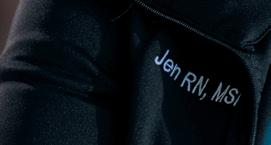






South, especially the lower Mississippi Valley and southern Appalachia, having particularly high prevalence of joint pain,” said first author Rui Huang, a doctoral student in sociology at the University at Buffalo.
that vary substantially in magnitude, even after adjusting for demographic characteristics," she said in a university news release.
The study examined moderate or severe joint pain due to arthritis.



In all, 6.9% of Minnesotans had arthritis pain, the study found. That compared to 23.1% of West Virginians.
Researchers also noted that percentage point difference between people who did not complete high school versus those who obtained at least a bachelor's degree was much larger in certain states than in others.
In West Virginia it was 31.1 percentage points; Arkansas, 29.7; and Alabama, 28.3. That compared to 8.8 in California, 9.8 in Nevada and 10.1 in Utah.
“Education can function as a 'personal firewall' that protects more highly educated people from undesirable state-level contexts, while increasing the vulnerability of less educated individuals,” Huang said.
The study notes that states can have dramatically different policies affecting opportunities, resources and social relationships. These factors can influence individuals' pain.




on nearly 408,000 adults aged 25 to 80 with state-level data about programs for SNAP food assistance, tax breaks for low- to moderate-income families, income inequality, community relationships, Medicaid generosity and tobacco taxes.


The study noted that some states offer more expansive SNAP benefits than others do. Those that did had populations with a lower prevalence of pain, as did those with stronger relationships among community members. This indicates that material resources and social function play a part in pain risk, according to the researchers.

“The increase in the generosity of SNAP benefits could potentially alleviate pain by promoting healthier eating habits and alleviating the life stress associated with food insecurity,” Huang said. “Social factors such as conflict, isolation and devaluation are also among the 'social threats' that can lead to physical reactions such as inflammation and immune system changes.”
About 59 million Americans have arthritis. At least 14 million experience severe joint pain, which can include diminished range of motion and disability.


“Chronic pain can — and should — be addressed through macro-level policies, as well as through individual-level interventions,” Huang said. “This study also implies that pain research in general should move towards a greater understanding of the macro contextual factors that shape pain and pain inequalities.”

“We also observed educational disparities in joint pain in all states
“Very little research has examined the geography of chronic pain, and virtually none has examined the role of state-level policies in shaping pain prevalence,” co-author Hanna Grol-Prokopczyk, an associate professor of sociology at the University at Buffalo, said in the release. “We were excited to identify state characteristics that reduce residents' risk of pain.”


Researchers combined 2017 data
SAVING LIVES SIDE BY SIDE





The findings were recently published in the journal PAIN. At





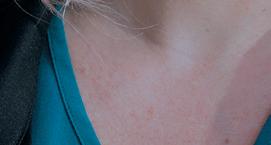




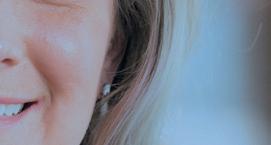








Page 2 • IN GOOD HEALTH – Buffalo & WNY’s Healthcare Newspaper • August 2023
ECMC,
of
other
Our
to our
with a rewarding work environment
to our professional development programs. Whether you’re just starting out or you’re a seasoned healthcare professional, ECMC is the perfect t to further your career.
the ECMC family of caregivers at ECMC.EDU/CAREERS THE BEST CARE HAPPENS WHEN WE COME TOGETHER.
each
us—from doctors, nurses, support sta , and specialists—is focused on not just healing the community but supporting each
at every turn.
commitment
employees starts
and continues through
Join
EC4033 In Good Health 1/2 pg ad (Nursing) (9.5 x 6.75).indd 1 4/18/23 7:20 AM
716 Health Location Opening Late Summer



111

Leaders in Orthopaedic Care
UBMD Orthopaedic & Sports Medicine



is the largest orthopaedics group in Western New York, and we are still growing.




Injuries from foot and ankle, hand and wrist to spinal conditions, joint, hip and back pain, knee, elbow, shoulder, concussion and sports medicine, our team of doctors, physical therapists, athletic trainers and other healthcare providers can help with any orthopaedic injury. We’re dedicated to being the best at making you better.
If you are between the ages of 18-70 and have been experiencing pelvic pain for more than three months, you may be eligible to participate in an NIH-funded study to evaluate 2 evidence-based, non-drug treatments for Urologic Chronic Pelvic Pain Syndrome (UCPPS). Qualified participants, male or female, will receive a noninvasive medical examination to confirm UCPPS and 10 weeks of treatment at no cost, with few clinic visits.


Qualified participants may receive up to $225 for their time.
een the ages of 18-70 and have been experiencing more than&three months, you may be eligible to NIH funded study to evaluate 2 evidence based, nons for Urologic Chronic Pelvic Pain Syndrome (UCPPS) pants, male or female, will receive a non- invasive ation to confirm UCPPS and ten weeks of treatment at w clinic visits Qualified participants may receive up to me.
If you are between the ages of 18-70 and have been experiencin pelvic pain for more than&three months, you may be eligible to participate in an NIH funded study to evaluate 2 evidence based, drug treatments for Urologic Chronic Pelvic Pain Syndrome (UCPP Qualified participants, male or female, will receive a non- invasive medical examination to confirm UCPPS and ten weeks of treatme no cost, with few clinic visits Qualified participants may receive $225 for their time.

Health insurance is not needed to participate. Please call 716-898-6254 to learn more about this clinical study.
e is not needed to participate. Please call 716-898- 6254 bout this clinical study.
Health insurance is not needed to participate. Please call 716-898to learn more about this clinical study.
August 2023 • IN GOOD HEALTH – Buffalo & WNY’s Healthcare Newspaper • Page 3
North Maplemere Rd., Suite 100, Williamsville, NY 14221
Amherst | Buffalo | Depew | Niagara Falls | Orchard Park | Williamsville Trusted Orthopaedic Care for Bones. Joint. Muscles. Concussions. Team Doctors For: Call or visit ubortho.com 716.204.3200 Schedule an appointment today and get expert care from the largest medical group in Western New York. 100 Amherst Villa Road / Buffalo, NY 14225-1432 716.626.5808 / / MERCYFLIGHT.ORG GREAT PLACE TO WORK: WHY MERCY FLIGHT EMS IS A • DYNAMIC PEOPLE • EXCITING LEARNING OPPORTUNITIES • MERCY FLIGHT GIVES BACK TO THE COMMUNITY • FLEXIBLE SCHEDULING AVAILABLE • COMPETITIVE COMPENSATION AND BENEFITS • DEVELOP YOUR EMS CAREER WITH MERCY FLIGHT • STATE-OF-THE-ART EQUIPMENT Mercy Flight, Inc. is an equal opportunity employer and a proud supporter of the WNY community. JOIN OUR TEAM Apply today at mercyflight.org/join-our-team We have immediate opportunites for full-time and part-time positions with the Mercy Flight EMS team for Dispatcher, Certified First Responder, EMTB, A/EMT, A/EMT-CC and EMT-Paramedic candidates. Pay rates are commensurate with experience, starting at: CFR Drivers $15.65/hr EMT-Basic $17.85/hr A/EMT $18.85/hr A/EMT-CC $23.50/hr EMT-Paramedic $24.50/hr Dispatcher $18.40/hr • 401(k) with 3.5% Employer Match for all employees • Wide variety of health and welfare benefits available for full-time employees at Buffalo - Behavioral Medicine Clinic Pelvic Pain Bringing You Down?
UB Behavioral Clinic
8-6254 ppic.com University at Buffalo - Behavioral Medicine C Pelvic Pain Bringing Yo Down?
at: 716-
Call the UB Behavioral Medicine Clinic at: 716898-6254 ubeppic.com
CDC Gives Full Approval to RSV Shots for People Over 60
Americans ages 60 and up can get their vaccine for respiratory syncytial virus (RSV) this fall, the U.S. Centers for Disease Control and Prevention announced recently.

Physician Rochelle Walensky, the outgoing CDC director, gave her signature to a recommendation made by an advisory panel of outside experts for a single dose of the vaccines made by Pfizer and GSK. The FDA sanctioned the shots in June for adults 60 and older.
The CDC added in a statement that it is advising seniors to first consult with their doctors to determine if the vaccine is right for them.
These higher-risk adults can get a single dose of either the Pfizer or GSK vaccine, both of which have already been approved by the U.S. Food and Drug Administration.
While some, including Robert Blancato, executive director of the National Association of Nutrition and Aging Services Programs, wanted the CDC to give a stronger vaccine recommendation for those ages 65 and up, the advisory panel offered the weaker endorsement after raising questions, the AP reported.
Those included how well the vaccine worked in those who were most frail, whether there might be a need for boosters and costs, the AP reported.
Pfizer has not revealed their pricing plan. GSK plans to charge between $200 and $295 a shot.
RSV can appear like the common cold, but can be dangerous for infants, children and the elderly, the AP reported. Those adults considered most at risk have chronic heart or lung disease, a weakened immune system or live in a long-term care facility.
New RSV vaccines may soon be approved for pregnant women, to help prevent their infants from becoming sick.
Meet Your Doctor
By Chris Motola
Q: Tell us about your work with addiction medicine and what “whole person care” means in that context.
A: I have done some work with addiction medicine research in the past. Addiction medicine is a very important aspect about caring about patients as a whole. Looking back before the pandemic, opioid addiction was a major health issue. It still is, but it was overshadowed by COVID the past few years. When I was a fourth-year medical student, I worked on a project that looked at opioid addiction recovery. And part of that project was to look at some novel and nontraditional ways we could treat opioid addiction. One of the things we looked at was spirituality as part of a whole-person approach. We found that a lot of patients did very well if they incorporated a bio-pyschosocial-spiritual model of recovery. It may not work for everyone, but it’s another tool in our toolbox that we can utilize to help folks along with their recovery.
Q: From a medical perspective, what is the role something like spirituality plays in recovery? Is it offloading some burden or neuroticism to an external construct?
A: Again, it may not work for everybody, but for some people it can be an effec tive aspect of treat ment. Essential ly for folks who are interested working on a spiritu al aspect of their lives it can provide a source of comfort and strength. It can provide a community
to opioids
through a place of worship, which in turn can provide support for overcoming whatever medical condition or concern they have. For some folks, this is something that can be very helpful.
Q: Do you think we’re making progress in the opioid crisis?
A: It’s a challenging problem and remains a problem in terms of public health, but it’s one that we can once again put to the forefront with COVID winding down. So we can once again give it more attention as a medical profession and as a society.
Q: So you were doing your residency during the COVID-19 pandemic. Lucky you.
A: That’s right. My residency cohort started in 2020, just months after things got really bad. So it was a real challenge not only starting during a pandemic, but completing the whole of my residency during it. Now, fortunately things have calmed down over the past year, but for most of my training, we had to deal with COVID. Because so many patients got so sick and decompensated so quickly, we had to engage in many difficult conversations with not just the patients but with their families, their wishes and coming to terms with their prognosis. So for us it was an opportunity to practice that whole-person approach to medicine and dealing with the full spectrum of their needs and wishes.
Q: What do you think the pros and cons of having done your training under those conditions are now that you’re through it? Are you unprepared
A: Well, volume is a huge difference. The hospitals were just full while COVID was raging, so it was a much higher workload. We also saw patients that were much sicker than the average patient normally is. And that’s because the ICUs were so full of critically ill patients. We had to learn how to manage patients who were at serious risk of decompensation. Something else this pandemic taught us was empathy. How do you speak with
and manage patients, and the families of patients, when they’re dealing with serious end-of-life issues.
Q: You’re winding down your residency training now, but you’ve been recognized for a couple honors, including the American Academy of Family Physicians President’s award, and were inducted into UB’s chapter of the national honor medical society Alpha Omega Alpha.

A: The Alpha Omega Alpha induction is something I’m particularly proud of. It’s an honor that is bestowed upon physicians for service and character. It’s one my program director recommended me for during my second year of residency. I submitted an essay, and she wrote a letter of recommendation for me, and I was selected from amongst a pool of very deserving applicants. It’s a wonderful honor and one I’m very proud of.
Q: What kind of work will you being doing post graduation?
A: I’m a family physician. I just recently graduated from residency. I’m going to be starting with UBMD Family Medicine of Amherst this coming fall. I’ll be seeing patients in an outpatient setting from newborns, through adolescence, through adulthood and old age. We care for a variety of acute and chronic issues, from heart issues to diabetes. Another aspect of our job that’s unique is that we can do some inpatient work as well. So every couple months we spend a week managing inpatient services at Millard Fillmore Suburban Hospital where we care of admitted patients while they’re in the hospital. I’ll be seeing a broad spectrum of patients from children to adults when I start. Anyone who comes in, I’m looking forward to treating.
Q: What are you looking forward to most when you get started?
A: One part I’m looking forward to in particular is working with our family medicine residency program and working with new and existing residents and helping them to train them to be the best doctors they can be as part of the faculty.
Lifelines
Name: Steven Foulis, M.D.
Position: Family physician at UBMD
Hometown: Pendleton
Education: Medical degree from the Jacobs School of Medicine and Biomedical Sciences; residency also at Jacobs School of Medicine and Biomedical Sciences
Affiliations: Millard Fillmore Suburban Hospital
Honors: Recipient of the American Academy of Family Physicians
President’s Award at the Jacobs School; inducted as a member of UB’s chapter of the national honor medical society, Alpha Omega Alpha; induction is the “the highest honor than can be bestowed in our profession” and signifies the lasting commitment to professionalism, leadership, scholarship, research and community service.
Research: Has conducted research on the role whole-person care can play in addiction recovery

Organizations: American Academy of Family Physicians; American Medical Association
Hobbies: Outdoor activities, Bills and Sabres fan, new restaurants, taking care of pet rabbit.
Page 4 • IN GOOD HEALTH – Buffalo & WNY’s Healthcare Newspaper • August 2023
Steven Foulis, M.D.
New UBMD doctor recalls starting residency right at the beginning of the pandemic; believes spirituality as part of whole-person approach can help some of those addicted
Over a Third of Americans Opt for a ‘Sleep Divorce’
Whether it’s to avoid partners who steal the covers and toss and turn all night, or those who consistently rattle the room with loud snoring, many Americans are opting for a “sleep divorce” to help improve their nightly sleep.
According to a recent American Academy of Sleep Medicine (AASM) survey, more than one-third of people say they occasionally or consistently sleep in another room to accommodate a bed partner.
Men are most likely to hit the sofa or guest room, with almost half of males (45%) reporting they occasionally or consistently sleep in another room, compared with just one-fourth (25%) of women.

“We know that poor sleep can worsen your mood, and those who are sleep deprived are more likely to argue with their partners. There may be some resentment toward the person causing the sleep disruption which can negatively impact relationships,” said Seema Khosla, pulmonologist and spokesperson for the AASM. “Getting a good night’s sleep is important for both health and happiness, so it’s no surprise that some couples choose to sleep apart for their overall well-being.”
Getting the right amount of healthy sleep is important for relationships. Studies have shown that those in relationships who consistently experience poor sleep are more likely to engage in conflict with their partners and that sleep loss decreases levels of empathetic accuracy — meaning those who do not have enough sleep may be less able to understand or interpret their partners’

feelings.

Almost half (43%) of millennials occasionally or consistently sleep in another room to accommodate a bed partner, followed by one-third (33%) of those in Generation X, 28% of those in Generation Z and 22% of baby boomers.
“Although the term ‘sleep divorce’ seems harsh, it really just means that people are prioritizing sleep and moving into a separate room at night when needed,” said Khosla. “However, if it is one part ner’s loud snoring that is leading to separate sleep spaces, then you should encourage that partner to talk to a doctor about obstructive sleep apnea. This applies to both men and women who may snore.”
Loud and frequent snoring is not just a nuisance; it is a common symptom of sleep apnea. While not everyone who snores has this sleep illness, snoring is a warning sign that should be taken seriously. When snoring is paired with choking, gasp ing or silent breathing pauses during sleep, it’s a strong indicator of sleep apnea.
Other common symptoms of sleep apnea include fatigue or day time sleepiness, unrefreshing sleep, insomnia, morning headaches, noctu ria (waking during the night to go to the bathroom), difficulty concentrating, memory loss, decreased sexual desire, irritability, and difficulty staying awake while watching TV or driving. Excess body weight is a key risk factor for sleep apnea.
For more information, or to find a local AASM-accredited sleep center, please visit sleepeduation.org.


SERVING WESTERN NEW YORK

Editor & Publisher: Wagner Dotto
Writers: Deborah J. Sergeant, Jim Miller, Gwenn Voelckers, Anne Palumbo, Brenda Alesii, Ernst Lamothe Jr., George Chapman, Amanda Jowsey, Daniel Meyer



Advertising: Anne Westcott, Amy Gagliano, Pam Roe
Layout & Design: Angel Campos-Toro Office Secretary: Allison Lockwood
August 2023 • IN GOOD HEALTH – Buffalo & WNY’s Healthcare Newspaper • Page 5
A monthly newspaper published by Local News, Inc. Distribution: 25,500 copies throughout more than 1,500 high-traffic locations. In Good Health is published 12 times a year by Local News, Inc. © 2023 by Local News, Inc. All rights reserved. P.O. Box 550, Amherst, NY 14226 Phone: 716-332-0640 • Fax: 716-332-0779 • Email: editor@bfohealth.com
No material may be reproduced in whole or in part from this publication without the express
this publication is
to
to
written permission of the publisher. The information in
intended
complement—not
take the place of—the recommendations of your health provider. Consult your physician before making major changes in your lifestyle or health care regimen.
Early Childhood School Age Adulthood PNWNY Support · Educate · Connect · Empower We support families and professionals who empower individuals with disabilities to reach their full potential through education and resources. 7 1 6 . 3 3 2 . 4 1 7 0 info@parentnetworkwny org We provide 1-On-1 Support and Education on Disabilities, Special Education and Services. www.parentnetworkwny.org Parent Network of WNY ParentNetworkWNY PNWNY Ask a b out ou r M o v e- i n Specia l ! WNY ’ s M ost Af f o r dab l e Assisted L i vi ng & M emo r y Ca r e Contact Us! 716-632-3000 410 Mill St., Williamsville, NY 14221 www.park-creek.com Stimulating social, educational and recreational activities Medication management Access to 24-hour personal care assistance Affordable memory care Enhanced assisted care ParkCreek_WNY_89.indd 1 Highest Prices Paid We BUY TEST STRIPS We will pick up and pay on the spot We pick up 6 days a week. 11am to 6:30pm One Touch Ultra & Freestyle Lite. All Brands Considered. Up to $50. (585)-284-3455
in common.
similar interests and hobbies.
By Gwenn Voelckers
tips, and for alone
Practical tips, advice and hope for those who live alone

Making New Friends: It’s Never Too Late
Question from a reader
I’ve been divorced for about a year now, and struggle with loneliness. I miss the friends we shared as a couple, but I’m just not comfortable socializing with couples anymore. I’m 58, and it feels awkward to try to make friends at my age. Any advice for me?
Answer from Gwenn
You’re not alone. Unfortunately, what you are experiencing often happens in the aftermath of a separation or divorce, especially if it was acrimonious. Friends’ loyalties can be split and, just as you feel uncomfortable relating to your former “couple” friends, some couples may feel uncomfortable relating to a now-single friend.
So how do you meet new people and cultivate friendships as an adult? Here are a few tips:
• First, be your own best friend
Taking care of yourself matters. Loving yourself shows. When you feel good about yourself you radiate a calm confidence and kindness that invites people in.
Healthy, positive people attract and gravitate to other healthy, positive people where friendships can flourish.
• Do more of what you enjoy doing
You won’t make new friends sitting alone at home. Get out of the house and do those things that bring you joy, whether it’s practicing yoga, learning a new language, taking a cooking class, playing music or any number of activities that put you with others.
You’ll meet people who share and appreciate your interests and aspirations, which — to quote Humphrey Bogart in “Casablanca” — could lead to “the beginning of a beautiful friendship.”
• Consider a support group
It’s not uncommon for new friendships to be borne out of compassion and empathy. A divorce or grief support group will put you in touch with others facing similar challenges.
A friend of mine met her second husband in a divorce support group. She shared, “We got to know each other as friends first, and have remained ‘best friends’ throughout our marriage. It’s the best thing that ever happened to me.”
• Say “yes” to invitations and opportunities to be with people
Circulating at neighborhood porch parties, gallery openings, retirement parties, weddings, etc. can be the ticket to making a new friend. You’ll be out and about with people with whom you share something
Board Games Could Be a Win for Your Kid's Math Skills
Family game night can be more than just a fun time: New research suggests it may even help build some early math skills in young children.

While past research has pointed to games as a way to enhance reading development and literacy, a new comprehensive review finds that number games like Monopoly, Othello, and Chutes and Ladders may help children with math.
“Board games enhance mathematical abilities for young children,” said lead author Jaime Balladares, from Pontificia Universidad Católica de Chile, in Santiago. “Using board games can be considered a strategy with potential effects on basic and complex math skills. Board games can easily be adapted to include
learning objectives related to mathematical skills or other domains.”
These number-based games help improve counting, addition and the ability to recognize if a number is higher or lower than another for young children, according to the study.
Children benefit when they play board games a few times a week supervised by a teacher or another trained adult, the study authors said.
The researchers reviewed 19 studies published from 2000 onward involving children aged 3 to 9. Most of the studies focused on the relationship between board games and mathematical skills.
The children each received special board game sessions about twice a week for 20 minutes over about
Show up and don’t be shy about extending an invitation to someone you meet. It could be a cup of coffee, drinks after work or walk in the park.
• Don’t overlook your family
My sister is my best friend, and she helped me re-establish a network of friends after my divorce. I had gone into the proverbial “cave” and lost contact with practically everyone.
Her friends became my friends, and now, years later, I enjoy the company of her friends, as well as my own.
• Rekindle relationships with old friends
It happens. It’s not uncommon for friends to drift apart when careers, marriage, kids or other life events require time and focus. But things change. Life marches on and many of us have retired and become empty nesters. You now have glorious time on your hands to reconnect with old friends — friends who were an important part of your life at one point and may still have lots to offer.
Just yesterday, I got a text from an old friend. It began, “It’s been ages! I just retired in June after 34 years. I’d love to connect.” We are meeting next week.
It’s as easy as that! You can do it.
• Give a “singles” event a try
Many divorced or widowed women and men find fun and friendship in community activities organized just for singles. It could be a movie night, dining out, hiking, biking, kayaking, you name it.
You can find these opportunities online in community calendars or in local newspapers. You could also check out www.meetup.com for a wide-ranging list of activities, gatherings, and events for people with
six weeks.
Some of the studies grouped children into either the number board game or to a board game that did not focus on numeracy skills, while in other studies all the children participated in number board games but were assigned different games.
All children were assessed on their skills before and after the interventions, with the authors rating success in four categories, including the ability to name numbers; basic number comprehension (such as nine is greater than three); the ability to add and subtract; and interest in mathematics.
In some cases, parents were provided training on using math in games. The results showed that children had significantly improved math skills for more than 52% of tasks analyzed. In 32% of cases, children in the intervention groups gained better
• Volunteer or champion a cause
Supporting an organization or cause you believe in will put you in contact with people working toward a common goal.
Community gardens, political parties, hospitals, museums, animal shelters and many other organizations often need volunteers. Strong connections can be made when you work alongside others who want to make the world a better place to live, work, play and pray.
Friendships enrich our lives. Good friends are there for you in hard times when you need someone to lean on. And they are there for you in good times to help celebrate life’s successes and happy moments.
When I’m in the company of my good friends, I feel a warm sense of belonging. They know me and I know them. We laugh and cry together, prop each other up, and share our deepest feelings and fears, hopes and dreams, and of course, favorite recipes and movies.
My friends are family.
If you are feeling lonely or left out, know that you can always meet new people, make new friends, and nurture existing ones. It’s never too late.
Gwenn Voelckers is the founder and facilitator of Alone and Content, empowerment workshops for women and author of “Alone and Content,” a collection of inspiring essays for those who live alone. For information about her workshops, to purchase her book, or invite her to speak, visit www. aloneandcontent.com
results than those who did not take part in the board game intervention.
The findings were published online July 6 in the journal Early Years.
“Future studies should be designed to explore the effects that these games could have on other cognitive and developmental skills,” Balladares said in a journal news release. “An interesting space for the development of intervention and assessment of board games should open up in the next few years, given the complexity of games and the need to design more and better games for educational purposes.
Page 6 • IN GOOD HEALTH – Buffalo & WNY’s Healthcare Newspaper • August 2023
Live Alone & Thrive
Q & A with Renee Likong
By Brenda Alesii
Ever been inspired by a song?
Renee Likong, a licensed practical nurse (LPN) since 2005, was listening to her car radio in a storm when “Lift Me Up” by Rihanna started playing. It motivated Likong to present the idea of hosting a national convention in Western New York honoring licensed practical nurses at the M Hotel on Walden Avenue in Cheektowaga from Oct. 11 – 14. Her proposal was accepted, meaning that dozens of healthcare workers will visit the Buffalo area to learn and network.
In Good Health recently spoke to Likong, a Buffalo resident, Marine Corps veteran, and president of the New York State Chapter of the National Association of Licensed Practical Nurses.

Q. This will be the first gathering in the area of United States members, which will coincide with the 75th anniversary of the national chapter’s founding. Why did you think the Buffalo area would be a
ECMC Among Nation’s Best For Social Responsibility and Health Equity
Erie County Medical Center has again been recognized by the Lown Institute for outstanding social responsibility, receiving an “A” grade on the 2023-24 Lown Institute Hospitals Index.
ECMC achieved this honor through strong performance across metrics of health equity, patient outcomes and value of care, out of more than 3,600 hospitals nationwide.
In 2021, ECMC was ranked among the top 100 hospitals in the United States for racial inclusivity by the Lown Institute; in 2022 ECMC was ranked in the top 50 hospitals in the country for racial inclusivity.
good fit for the convention?
A. We must let nurses know we are not alone. Nurses are still dealing with the repercussions of COVID, we’re still facing different types of trauma — even being beat up in some situations — and there’s always the issue of staffing shortages. We’re so excited to be the host organization that brings together, for the first time since the pandemic, nurses and healthcare workers from all corners of the U.S. and we happen to be doing this on the anniversary of the founding of our national organization by Lillian Custer in 1948. I’m a proud New Yorker and am glad to bring it home. It’s our foundation.
Q. This isn’t the first time you’ve sponsored an event of this magnitude, right?
A. In 2019, we sponsored it at Shea’s Seneca in Buffalo, so I contacted the people who ran this one and asked if they could re-create their very successful event again to start
our convention. They agreed and jumped right in. They had put a hold on the event from 2020 until now due to COVID but are eager to go all out for us starting on Oct. 11th. It will be even bigger and better this year.
Q. What is the role of an LPN?
A. LPNs have advanced in so many arenas, including being directly in charge of patient care. I became a nurse because I’m patient-focused and wanted to understand what makes a person ill, and how to make the situation better. We are integral to the health care arena. In the past, licensed practical nurses were never allowed to do certain procedures, but now things have opened up. LPN duties and responsibilities now include treatments such as wound care and IV therapy. We continue to work in a variety of positions: asthma educator, nephrology care, hospice and palliative, and certain types of brain injuries.
Q. Do you think in the hierarchy of personnel — medical doctors, registered nurses, other practitioners — that LPNs are disregarded?
A. That perception is out there, but that’s one of the reasons our organization employs best practices and strives for the best care for our patients, and why we continue to advocate for LPNs. It’s important that we always know our scope of practice, otherwise we are doing a disservice to the patient and ourselves. I refuse to let any type of frustration I may feel negate anything I do. At the October convention here, we will continue to learn and earn continuing education credits and network with others in our field, which can only enhance our experiences in the field.
Q. Are you optimistic about the future of licensed practical nurses?
A. Yes. Learning and advocating for ourselves and other healthcare heroes is essential. This convention will go a long way towards that.
Q. How does one register for it?
A. It’s easy to register, just go to www.nalpn.org. Tickets for the Oct. 11 “Nurses Night – Celebrating All Healthcare Heroes” can be purchased at www.NursesNightofCelebration. com. It is open to all healthcare workers and their friends.
For more information, contact Likong at reneelikong@gmail.com,.
ECMC ranked 8 out of 138 hospitals in New York state and 350 of 3,637 hospitals nationally on the social responsibility metric.
According to the index, the hospital also received “A” grades in equity and value. These are independent rankings and hospitals do not apply or pay to be listed.
ECMC President and CEO Thomas J. Quatroche Jr., PhD, said: “This is just one more affirmation of ECMC’s commitment to our entire community and our daily focus on health equity and racial diversity. I thank the entire ECMC Family, led by our Board of Directors, who dedicate themselves every day to provide the best care with dignity, kindness and compassion to our region’s residents, ensuring that our healthcare services are inclusive of everyone who needs our care.”
2023-24 Lown Hospitals Index for Social Responsibility Recognition earned by Erie County Medical Center:
• Social Responsibility Grade: A
• Health Equity Grade: A
• Value of Care Grade: A
• Community Benefit Grade: A
• Inclusivity Grade: A
• Avoiding Overuse Grade: A
• Racial Inclusivity Grade: A
“When communities have access to socially responsible healthcare, our nation grows stronger,” said Vikas Saini, MD, president of the Lown Institute. “That’s why it’s so important to hold up these high-performing hospitals as examples for others to follow.”
The Lown Hospitals Index for Social Responsibility is the only ranking to include metrics of health equity and value of care alongside patient outcomes, creating a holistic view of hospitals as total community partners. In the fourth annual and largest set of rankings to date, the 2023-24 Lown Index evaluates hospitals on 50+ measures – including novel metrics such as community benefit, racial inclusivity, and avoidance of overuse — for more than 3,600 hospitals nationwide.
Data sources include Medicare feefor-service and Medicare Advantage claims, CMS patient safety data and hospital cost reports, and IRS 990 forms, among others. Full methodology can be found on the Lown Index website. The Lown Institute is a nonpartisan think tank that generates bold ideas for a radically better system of health.
Learn more at www.LownHospitalsIndex.org.
August 2023 • IN GOOD HEALTH – Buffalo & WNY’s Healthcare Newspaper • Page 7
President of the NYS chapter of the National Association of Licensed Practical Nurses is bringing LPNs and healthcare workers from across the country to Buffalo
“
We must let nurses know we are not alone. Nurses are still dealing with the repercussions of COVID, we’re still facing different types of trauma — even being beat up in some situations — and there’s always the issue of staffing shortages.
Men Die of Overdose 2-3 Times More Than Women
By Deborah Jeanne Sergeant
Men died of opioid and stimulant drugs at a rate two to three times higher than women between 2020 and 2021, according to a recent study. The data looked at fentanyl, heroin, methamphetamine and cocaine.
The study said that men’s higher rates of use do not entirely account for the increase in mortality risk.
The study was published by Neuropsychopharmacology and led by investigators at the Icahn School of Medicine at Mount Sinai in New York City and the National Institute on Drug Abuse, part of the National Institutes of Health.
“Though men and women are being exposed to the modern, fentanyl-contaminated drug supply, something is leading men to die at significantly higher rates,” said Nora Volkow, physician and director of NIDA and one of the co-authors on the study in a press release. “It may be that men use drugs more frequently or in greater doses, which could increase their risk of death, or there may be protective factors among women that reduce their risk of death compared to men.”
The study indicated that further research must be done to determine why more men die from stimulant and opioid overdoses than women.
The numbers ring true in Erie County. The Department of Health’s statistics related that men outnumber women for opioid related deaths at a ratio of 2:1.
Bridget Vaccaro, family nurse practitioner and clinical director
at Neighborhood Health Center’s Northwest location in Buffalo, thinks that socially constructed beliefs about gender are driving behavioral differences that result in higher overdose rates, with men less likely to seek treatment.
“Men do not seek help as much as women,” she said. “Men do not admit they need help; it’s a pride thing. Women are more apt to admit they need help at a certain point.”
She added that women may be more motivated to seek help because they do not want to be separated from their children.
“Men statistically start substance use at an earlier age,” said Carolyn Grisko director of clinical services at Beacon Center in Buffalo. “They may have had a longer history of use and bigger tolerance.”
There’s also the factor of men eschewing healthy ways of dealing with trauma and stress and turning to drugs. Grisko said that women tend to deal with trauma issues without feeling that doing so exhibits weakness.

The causes of opioid dependency may shed some light. Joshua Lynch, doctor of osteopathic medicine and emergency medicine physician at UBMD Emergency Medicine, said that women have higher rates of prescription opioids for chronic pain than men, “and men have higher rates of illicit drug use,” he added. “That’s one piece.”
The lack of safety of illicit drugs would translate to higher death rates, along with men being more likely to
or other substanc-
“It’s an interesting and troubling statistic, but it leaves us with more work to do before we come up with a clear-cut answer,” he said.
Evan Frost, assistant director of communications and public information at the NYS Office of Addiction Services and Supports in Albany, said that more than 70% of treatment admissions are male.
“A higher prevalence of substance use disorder in men is not new and has been a steady trend in both New York state and the rest of the country for years,” he said.
As to why more men are dying — especially since they’re entering treatment programs at higher rates — is not entirely clear.
Most of the programs OASAS offers are oriented toward men or are men-only, including programs on parenting, relationships in early recovery, anger management and specialized services for those involved in the criminal justice system.

“In general, we are also addressing opioid overdoses by increasing access to care through low-threshold access to medications for opioid use disorder, providing overdose prevention education and naloxone and providing fentanyl and xylazine test strips so people who use drugs can be informed about what is in their supply,” Frost added.
The Erie County Opiate Epidemic Task Force offers an extensive array of services.
“Our department has peers, support groups, an extensive distribution system for Narcan and other harm reduction supplies like fentanyl test strips, a Text for Narcan program (716-225-5473), outreach with education, and Narcan training for individuals, groups and businesses–virtual at www.erie.gov/opioidtrainings and in-person,” said Cheryll Moore, director of the Erie County Opiate Epidemic Task Force.
Page 8 • IN GOOD HEALTH – Buffalo & WNY’s Healthcare Newspaper • August 2023 Addiction
Higher rates of use do not entirely account for the increase in mortality risk for men
Drugs that Kill — Men Die at Higher Rates Deaths per 100,000 Synthetic opioids (e.g., fentanyl) Heroin Psychostimulants (e.g., methamphetamine) Cocaine 29 5.5 13 10.6 11.9 2 5.6 4.2 Men Drug Women Source: National Institutes of Health
said that other biological differences between men and women could be present.
combine alcohol
es and opioids. But Lynch
TEENS AND TOBACCO USE

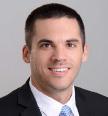
Tobacco use was declining… then e-cigarettes came along
By Deborah Jeanne Sergeant
Teens seem to be getting the message on the dangers of smoking cigarettes. Their use continues to plummet among teens.
Among this age group, tobacco use continues largely thanks to vaping. Part of the reason for their popularity is that teens perceive e-cigarettes as safer than incendiary cigarettes.
Originally, vaping was marketed as a tool for smoking cessation, in fact.
“While youth are certainly getting the message that vaping is not what it’s cracked up to be — the rates are declining a little bit — we’re dealing with some youth who get addicted to nicotine at extreme rates because the products have such high concentrations of nicotine,” said Tony Astran, media contact for The New York State Smokers’ Quitline.
The Quitline is a service of the New York State Department of Health and based at Roswell Park Comprehensive Cancer Center in Buffalo.










A Hyde vape contains about 1.8 ml. of liquid, which equals 25-50 mg. of nicotine. That’s equal to one pack of cigarettes. Unlike a cigarette, which burns up to indicate that “serving” of nicotine has been consumed, a vaping device has no clear end point. Using a vape is like eating from a carton of ice cream
with a spoon compared with the cigarette, which offers portion control more like that of eating an ice cream sandwich.

Nicotine affects youth differently from adults.


“We know that the brain is still developing up to age 25,” Astran said. “Nicotine can stunt development and cause jitters and lack of focus and other problems, especially important as youth are going to school. This is exactly what you do not want to happen. If you start younger on nicotine, the more likely you’ll get addicted for life.”
The US Food and Drug Administration banned most flavored vaping liquid in 2020. However, the ban covered only flavored cartridges and pods, not tanks or disposable flavored e-cigarettes.
“Big tobacco is constantly trying to stay one step ahead,” Astran said.
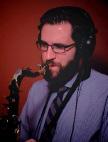



Exploiting that loophole has kept candy and fruity flavors — popular with teens — available in the market.
Since e-cigarettes emit vapor, it seems safer than smoky cigarettes. But the vapor contains a mix of largely unknown chemicals not FDA-regulated for inhalation. Most of the vaping liquids on the market are sourced from companies in countries that use less stringent consumer safety standards than the US.

The appeal of the sleek device,
which often looks like a USB flash drive, also attracts teens. It’s easy to conceal from their parents because the vapor smells like fruit and the device appears harmless as well.




“Far too many parents aren’t clued in,” said Jenna C. Brinkworth, community outreach and engagement manager for Roswell Park Comprehensive Cancer Center in Buffalo. “It’s not harmless water vapor. It’s highly addictive. They need to know what the devices look like.”

“If they ask, listen and look, those can be really important things to do and to keep in mind. We’re finding that youth who start vaping are more likely to start smoking combustible products. That has the tar and all of those harmful effects. There’s no reason at all for teens to start vaping. Some parents say it’s a better alternative to smoking or other substance but it’s not true,” she added.


Prevention is obviously better than quitting. Parents need to take the lead by setting a good example and not using substances themselves. It may seem like teens want to be anything but like their parents, but the parental example ingrains in children early on what is acceptable behavior.


As always, the peer group also matters. Teens may vape to fit in or
Teens may vape because they feel it will help them de-stress. For this reason, it’s vital to promote healthy ways of managing stress and to avoid over-scheduling and heaping up unrealistic demands. Teens need downtime as well as adults.






“Teens today have so many challenges,” Brinkworth said. “Stress, anxiety and depression are never like before. Kids who are vaping and using THC have higher stress, anxiety, depression and suicidal thoughts compared with kids who do not use. They are turning to nicotine to relax or be with peers. But it’s only building upon those problems and making it harder to deal with those issues.”
Many healthcare professionals have only begun asking teens about vaping in well child visits.
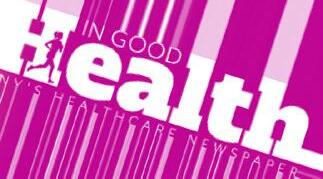


Bridget Vaccaro, family nurse practitioner and clinical director at Neighborhood Health Center’s Northwest Buffalo location, said that any patient aged 12-21 receives a screening for substance use, including nicotine, “but we don’t include vapes,” she said. “We don’t consider it a tobacco product. I didn’t give a lot of these topics a thought until I had kids, now 9 and 6. I look at them and realize I have to educate parents and families on the things I talk about at home. I know this stuff because I’m an educator and medical professional.”
Use of Tobacco Products

The New York Youth Tobacco Survey reveals that in 2014, 10.5% of New York high school students use e-cigarettes. That percent has climbed to 22.5% in 2020 and, the most recent figure, is 18.7% in 2022. The percent smoking incendiary cigarettes was 7.3% in 2014, 2.4% in 2020 and 2.1% in 2022. Overall tobacco use (cigarettes, vapes and other types such as cigars, oral pouches and cigarillos) has climbed from 19.5% in 2014 to 25.6% in 2020 and dipped down a bit to 20.8% in 2022.
• Vaping cessation resources from the New York State




IN GOOD HEALTH – Buffalo & WNY’s Healthcare Newspaper • Page 9
Addiction
ALSO INSIDE Alzheimer’s U.S H spitalsAreG ttingSafer orPatients P. Finally LowerDrugPrices ButW it… Just8%LackHealthInsuran e aRecordL w P B OHEALTH.COM EPTEMB R 022 S UE95 Asidefromhigher iskoflungancer,menwhosm keare moreprone o d velopearly impo en e owerspe m ou andgreat riskofp ate cancerandca diovascular diseases y xper P.16 P T TLESLEEP MKIDHARMYOUNG S’BRAINS FREE D THECAREGIVE MEN&SMOKING BettertreatmentsforthosediagnosedwithAlzheimers areonthehorizon,say localexperts Q&AwithAmandaNobrega interim directoratCiticolineAlzheimer’sAssociationWNYChapter ApossibleAlzheimer’streatmentSeeAlzheimers:Pages6 10-12 ATRICS Physicia Fr dD A ch inte imdivision hief Ped trics disc sse h st ble o tin athome nt ib e tokids’su essin schoo st ss ed ction STROKE AreSchoolsSafe? Nineteenchildrenandtwoteacherswere killedUvinashootingatRobbElementarySchoolin alde Texa Askidsgearuptoreturn toour localschools,how safearethey? Page 13 BACK TO SCHOOL SPECIAL BFOHEALTH.COM AUGUST2022•ISSU 9 ErieCounty HasanSTI ProblemGonorrheacasesareup56% syphilis casesdoubled problemisworse for peoplewholiveinZIPcodes 14214 and14211 Story npage 7 � d FaceToday P1 � FamilyMeals WhyTheyres Impo ta P.1 � CampCradleBea h Unitin 16 ALSO INSIDE Physicia Robe S wy r,drect o th S keC nt atth Gate a ula In tit t talk b utfivething yo know t k w ab u it P.9 INSIDE:WELLNESSSPECIALISSUE IN MEDICINE Integr complem Fromreflexologyto Find13healthmodalities FREE Rutk wski ologistwith UBMDUology discussese ectile dysfun tion‘It’ ftenaharbinger ofbadthingst om hesa sof the ondition ERECTILEDYSFUNCTION JAZZMEETTHE DOCTORP19 N May;agreat tim sfortheirincredible,tedandcontinuedwork CELEBRATING NURSES BFOH A TH.COM MAY 022 IS UE 9 FREE FREE BFO EALT C M AP IL2022 IS UE90 DanielSi ic is eu oogist.He discu Pa kinson disease deep brainsti ul tion imp ove som mot sym P4 TREMORSDISEASEARKINSON’S MENTALHEALTH ■ Sig syo ne m ta h lth help■ Po bod HOWTOSLEEPBETTER ResearchersattheUniversi y BuffaloSchoolofNursingandRos ellP rk Comp ehensi e Cancer Centera conductinganinsomniastudy tohelpcan patientsgetabeternight’ssleep PLUS:Wr ter AnnePalumb authorofSm lists eventypesoffoodth tcanhelpyousleepbet M GOING ON A WEIGHTGAIN JOURNEY Children ha e be n throughan a full tin con tantstress from f milyfinan o erage; ver-shifting C been hard FOHEALTH.COM MARCH20 2 ISSU 89 HOT HEALTHCARE ISSUES IN WNY Reach over 80,000 health conscious readers in WNY (based on 25,000 copies distributed) Call 716-332-0640 or email editor@bfohealth.com to request a media kit. Make In Good Health newspaper your advertising choice
5 Superfoods to Add to Your Grocery List
By Amanda Jowsey
Trying to plan healthy meals to give us the most nutritional bang for our buck feels more crucial and daunting than ever.
Food prices rose by almost 10% from 2021 to 2022, according to the United States Department of Agriculture.
Easily get some extra nutritional value from your next trip to the grocery store with this list of my five favorite superfoods, reviewed by a local nutrition expert who helps to explain some of the health benefits — and dispel some of the myths — surrounding these amazing foods.

1. AVOCADO
I didn’t discover these “alligator pears” until later in life and I don’t know how I lived without them! They are mildly flavored and incredibly nutritious and diverse.
I know, they’re not the cheapest, but one bag will go a long way. Use them for guacamole, tacos, burgers and sandwiches, eggs and toast or even throw one in your next smoothie to make it creamier and more nutritious.
Danielle Meyer talked about the general health benefits of avocado, saying they are an excellent source of good fat, which promotes healthy cholesterol.
Meyer is a registered dietitian and a board-certified specialist in oncology nutrition at the UB’s Department of Exercise and Nutrition Sciences and School of Public Health and Health Professions.
“Avocados are an excellent source of [monounsaturated fatty

acids]. These are the same good fats we find in olive oil. Monounsaturated fatty acids can help with our heart health as they can lower our LDL [lousy or bad] cholesterol. Having your LDL cholesterol in a healthy range can help reduce your risk of heart disease and stroke,” Meyer said.
Avocados also contain anti-aging properties that can help you maintain a youthful, glowing appearance. A recent study published in The Journal of Cosmetic Dermatology found that regularly eating avocados — one avocado daily for eight weeks — is linked to increased skin elasticity and firmness in women.
Avocados are also gluten free, dairy-free, vegan and vegetarian, making them an excellent replacement for certain products like butter, mayo, sour cream, olive and coconut oil and even peanut and almond butter.
2. SWEET POTATO
Highly nutritious and loved by kids and adults, sweet potatoes are a strong source of vitamin A, vitamin C, beta carotene, potassium and fiber.
“Sweet potatoes are high in beta-carotene, a carotenoid [a type of phytochemical that is considered an antioxidant] that gives the sweet potato its color. Having a varied eating pattern that includes carotenoid-rich vegetables has been associated with reducing the risk of cardiovascular diseases and some cancer,” Meyer said.

Sweet potatoes may boost brain function and prevent cognitive decline. According to the NIH, people who eat a diet rich in fruits and vegetables that contain antioxidants are 13% less likely to experience mental decline and dementia.
Some claims suggest that consuming avocados can promote a healthy mind-body connection, but this connection “is still in its infancy
4. GARLIC 3. NUTS & SEEDS
They make a great snack just as they are (with cheese and fruit), can be used as toppings on ice cream and salads or can be used as a replacement for breadcrumbs in certain recipes.
They are a great source of fat, fiber, protein, and vitamins and minerals, and provide a well-rounded boost of nutrition for the body. Their unsaturated fat content can help protect against heart disease
and lower the risk of obesity.
They can boost cognitive function, enhance memory and attention, improve mood and reduce the risk of depression. A recent study published in The Nutrition Reviews Journal by Oxford Academic suggests “that higher nut consumption could be associated with a lower risk of depression, fewer depressive symptoms, and better mood state in the general population.”

You either love it or you hate it, but garlic is one of the most amazing foods.
It contains vitamin C, vitamin B6 and manganese (a coenzyme that helps break down carbs, proteins and cholesterol). Vitamin C is required for the growth, development and repair of all body tissues. Vitamin B6 helps to maintain a healthy brain function as well as a strong immunity.
In one randomized study, a daily garlic supplement reduced the risk of the common cold by 63% compared to a placebo. Another
of understanding,” Meyer said.
“The way food makes us feel, or the way we feel when we eat foods we view as healthy, can improve our mood, but it is not always related to the food itself. It can also be that we acknowledge we are doing something good for ourselves and that in turn makes us feel better. There are also many other sources, more economical ones, that offer the same health benefits,” she added.
Sweet potatoes can promote healthy gut functioning because of their soluble and insoluble fiber content. Fiber-rich diets have been linked to a lower risk of colon cancer and more digestive regularity. The antioxidants in sweet potatoes also promote the development of a type of gut bacteria that is associated with a lower risk of gastrointestinal disease.
recent study suggests that consuming a high dose of garlic extract reduced the length and severity of illness with the cold or flu by 61%.
Several studies have confirmed that garlic supplements may also significantly reduce blood pressure in those suffering from hypertension. One study even found that garlic extract is as effective in treating hypertension as Atenolol, a commonly prescribed blood pressure medication.

Page 10 • IN GOOD HEALTH – Buffalo & WNY’s Healthcare Newspaper • August 2023
5. BLUEBERRIES
Although I do admit, their sometimes inconsistent and unpredictable ripeness is not my favorite; they still deserve a shout out. These tiny berries are jam-packed with nutrition, containing some of the highest levels of antioxidants of any fruit.
Think high nutrients, low calories. One cup of blueberries provides the following recommended daily intake of vitamins and minerals: vitamin C 24%, vitamin K 36%, manganese 25% and dietary fiber 14%.

They may also help to manage blood sugar, lowering the risk of heart disease. High fiber, lower sugar fruits like blueberries prevent insulin levels from rising too high which can promote a healthy endocrine system. They have also been shown to improve symptoms and lower blood pressure in those with metabolic syndrome (NIH).
Meyer wants readers to remember: “Superfood is a marketing term. Eating your favorite fruits and vegetables will give you the same benefits. Including a variety of colorful foods into your everyday eating pattern can help in numerous ways. This can be accomplished on a budget by purchasing frozen fruits and vegetables year-round and purchasing them in season when you have the option.
“Since all fruit could carry the moniker of a ‘superfood,’ one of the most cost-efficient ways of including these in your diet is to purchase frozen fruit. These are often picked at peak ripeness and there is no rush to for them to go bad waiting for you to use them. Many fresh fruits are picked just prior to ripening to allow for transportation time. Frozen is an excellent option for the best tasting fruit options year-round,” Meyer said.
By Anne Palumbo
SmartBites The skinny on healthy eating
Is Shrimp Good For You?
If you’re watching your cholesterol, you may be wary of eating shrimp. Next to squid, shrimp has more cholesterol than any other seafood, which depending on your intake can put a serious dent in your recommended amount. We’re talking up to 200 milligrams per average serving. Although I have high cholesterol, I continue to eat shrimp, maybe three or four times a month, swayed by the research from Harvard School of Public Health, which asserts that the biggest influence on blood cholesterol levels is the mix of fats and carbs in your diet — not the amount of cholesterol you eat from food. While some foods do earn cholesterol red flags — think high-fat baked goods, meats high in saturated fats, deep-fried foods — shrimp does not.
That’s because shrimp contains minimal saturated fats and negligible carbs. (Of course, red flags go up whenever shrimp is fried or served with a rich sauce.) Experts agree, however, that it remains important
to monitor the amount of cholesterol you eat, especially if you have heart disease, diabetes or “respond” to dietary cholesterol in a way that most people don’t. So, is America’s most popular seafood healthy? Yes, says the Academy of Nutrition and Dietetics, shrimp teems with beneficial nutrients. When it comes to low-calorie protein, shrimp is a superstar, with an average serving delivering about 25 grams of protein for only 135 calories. A workhorse nutrient, protein is an essential for tissue repair, muscle building, weight maintenance, and more. What’s more, shrimp boasts a unique mix of nutrients that supports brain health. From its omega-3s to its antioxidants to its vitamin B12,
all contribute to keeping our memories sharp, our moods bright, and our thinking clear. Lastly, this sweet crustacean is one of the best food sources of iodine, an important mineral for proper thyroid function and brain health.
HEALTHY GRILLED SHRIMP
Adapted from deliciousmeetshealthy.com Serves 6
1 lb. raw shrimp, peeled and cleaned
2 tablespoons olive oil
1 tablespoon lemon juice
1 teaspoon minced garlic
1 teaspoon regular or smoked paprika

1 teaspoon cumin
1 teaspoon onion powder
1 teaspoon kosher salt
½ teaspoon coarse black pepper pinch of red pepper flakes (optional)
1.Thaw shrimp in a bowl of cold water for 20 minutes.
2. Mix together olive oil, lemon juice, garlic and spices in a large bowl. Add shrimp, mix until coated, and let shrimp sit for 30 minutes.
3. Preheat the grill to medium-high; oil the grates.
4. Thread the shrimp on skewers and grill for 2 to 3 minutes per side, until shrimp are opaque. Serve immediately.

Anne Palumbo is a lifestyle columnist, food guru, and seasoned cook, who has perfected the art of preparing nutritious, calorie-conscious dishes. She is hungry for your questions and comments about SmartBites, so be in touch with Anne at avpalumbo@aol.com.


Helpful Tips
Fresh? Frozen? Farmed? Wild? Selecting the freshest, safest shrimp can be daunting! But here’s what the experts say: Unless you’re absolutely sure that the “fresh” shrimp at the counter are truly fresh-off-the boat, frozen shrimp are a better bet. Since there’s no way to know how long the “fresh” shrimp on display have been allowed to thaw, you’re better off buying frozen and thawing them at home. If you’re concerned about antibiotics in shrimp, it’s best to select wild-caught shrimp, which is never treated with antibiotics. Rest assured that shrimp caught and prepared in the United States does not contain antibiotics.

August 2023 • IN GOOD HEALTH – Buffalo & WNY’s Healthcare Newspaper • Page 11
Danielle Meyer is a registered dietitian and a board-certified specialist in oncology nutrition at the UB’s Department of Exercise and Nutrition Sciences and School of Public Health and Health Professions.
Back to School Caffeinated Teens
Some energy drinks on the market — such as Prime Energy pack a whopping 200 mg. of caffeine per 12-oz.
 By Deborah Jeanne Sergeant
By Deborah Jeanne Sergeant
From coffee to soda to energy drinks and energy shots, teens have plenty of options to get a burst of energy.
Terry Ratzlaff writing for The New York Times stated that energy drink sales in the US have swelled from $12 billion to $19 billion in the past five years.
But drinking these in excess can mask health problems and cause still other health issues among teens.
Dana Ingebretson, registered dietitian and the chairwoman of the wellness department at Neighborhood Health Center in Buffalo, listed sleep disturbances as one of the effects caffeine can have on teens.
“Teenagers should get between 8-10 hours of sleep because they’re in a time of high growth and development,” Ingebretson said. “Lack of sleep can lead to challenges with development, poor mental health problems with attention and behavior, diabetes and obesity. It can also impact hyperactivity and anxiety.”
She added that there aren’t recommendations for caffeine for children.
“That doesn’t mean kids can’t occasionally enjoy a soda or other kind of drink,” she said. “We want to promote water first, water the most, for hydration.”
Caffeine can also affect heart rate and blood pressure. Rachel Simson, registered dietitian and owner of Buffalo Dietitian, said that it stimulates the nervous system and can potentially affect cardiovascular health and lead to heart palpitations. Caffeine can also affect behavior, especially of tweens and younger teens.
“The effects of caffeine on the body may begin as fast as 15 minutes after ingestion and last up to six hours,” she said.
She added that it can also increase stomach acid secretion, production of urine and blood flow to the skin and extremities, as well as stunt brain development if consumed from a young age. .
“Caffeine may cause the body to
lose calcium,” Simson said. “Consuming too much caffeine could lead to bone loss over time. Caffeine may worsen underlying health issues, like heart problems. It can also interact with certain medications and or supplements.”
Instead of using caffeine as an energy source, she recommends boosting energy by getting enough sleep, drinking water all day for hydration and snacking on foods such as fresh fruit with yogurt; banana and nut butter; whole grain crackers with sliced cheese; or baby carrots and hummus.
Some teens reach for a cola or energy drink to replenish themselves while working out or playing sports. Many of these beverages contain high levels of sugar or artificial sweeteners.
“For athletes, make sure to focus on recovery and optimal fuel for practices and games,” she said. “If you continue to struggle with poor energy levels, please see your provider or meet with a registered dietitian.”
Drinking these caffeinated beverages can cause further dehydration as caffeine is a diuretic, meaning that it causes the body to create more urine.
The latest versions of energy drinks try to spin a healthier image for energy drinks, such as Celsius, which is made with things like ginger, green tea and vitamins. There’s also Prime Energy, a sugar-free drink with electrolytes, supplements—and a whopping 200 mg. of caffeine per 12-oz. can, equivalent to two 8-oz. cups of black coffee. Many parents confuse this beverage with the caffeine-free Prime Hydration, a sports drink.
This year, longtime sports hydrator Gatorade introduced Fast Twitch, a fruity, sugar-free drink that offers even more caffeine.
To consume all of this caffeine, teens must drink a 12-oz. energy drink; however, energy shots are highly concentrated sources of caf-
Memory Issues Could Be Another Struggle for Kids With Autism
Children with autism have wellknown difficulties with social interactions, but a new study is highlighting another area where they can struggle: memory.
Researchers found that compared
with their peers, school-age kids with autism showed more difficulty managing memory tasks. They often had a hard time remembering faces — something seen in past studies — but also in recalling words and other
feine, yielding 250 mg. of caffeine in only two ounces. It’s easy for teens to overdo since they can easily drink six servings or more of energy shots in a single sitting.
Because energy shots are classified by the FDA as supplements, they don’t fall under the same guidelines as food. The effect of the excessive supplements is not known.
Many teens see their parents and most other adults relying on caffeine to get through their day and assume that this is simply how to function.
“When we’re growing up, we see exactly what our parents are doing,” said Bridget Vaccaro, family nurse practitioner and clinical director at Neighborhood Health Center’s Northwest Buffalo location. “We don’t realize the impact caffeine has
for teens. You get a burst of energy and crash. It impacts social relationships, sleep patterns and school performance.”
Teens also draw from social media the notion that excessive caffeine is the way to go, especially energy drinks.
“It’s an epidemic of caffeinated Gatorade and Prime Energy,” Vaccaro said. “Social media and YouTube promote an idea that this is safe to do. Their bodies don’t need that. they don’t adjust well to it.”
The FDA’s guideline for maximum daily caffeine for adults is 400 mg. Most pediatricians agree that children younger than 12 should not consume caffeine. Those 12 to 18 should limit consumption to 100 mg. daily.
Guide to Caffeine
Soft drink (12 oz.)
Content
30-40 mg.
Green or black tea (8 oz.) 30-50 mg.
Coffee (8 oz.) 80-100 mg.
Energy drinks
Bang (16 oz.)
Alani Nu (12 oz.)
300 mg.
200 mg.
C4 (16 oz.) 200 mg.
5-hour energy shot (2 oz.) 200 mg.
Monster energy (16 oz.) 160 mg.
Rockstar (16 oz.)
160 mg.
Red Bull (8 oz.) 80 mg.
Source: Rachel Simson, registered dietitian and owner of Buffalo Dietitian
types of information.
What's more, the researchers were able to trace the memory deficits to particular brain circuitry that was "hyperconnected."
The findings suggest that memory challenges may be a bigger issue for kids with autism than generally recognized. And that should be taken into consideration at school and in services for those children, the researchers say.
Kids with "high-functioning" autism often go to mainstream schools and receive the same instruction as
their peers, said lead author Jin Liu, a postdoctoral researcher at Stanford University School of Medicine, in California.
But, she said, the new findings suggest that even though those children may have high IQs, they can still struggle with memory issues.
"So they may need extra help," Liu said.
The new study was published July 10 in Biological Psychiatry: Cognitive Neuroscience and Neuroimaging.
Page 12 • IN GOOD HEALTH – Buffalo & WNY’s Healthcare Newspaper • August 2023
Content Drink Caffeine
Back to School School Nurses: Frontline for Student health, Safety
Salary is lower but school nurses enjoy many perks not available to private practice nurses
By Deborah Jeanne Sergeant
The shortage of nurses in the hospital setting represents a longstanding concern for the healthcare industry. It has also affected school nursing positions. One reason is the pay rate.
According to the Bureau of Labor Statistics, the median annual wages for hospital nurses is $78,070. A nursing opening that Buffalo Public Schools listed online pays between $42,749 and $50,218. But school nurses enjoy a few special perks.
Hospital nurses usually work irregular shifts and hours and are often called upon to work longer shifts than school nurses. The nature of the work means that school nurses often get to know those in their charge.
“The Buffalo Public Schools is creating real opportunities as a place where teachers and other professional such as nurses can make a difference in the lives of all students,” said Jeffrey Hammond, director of public relations and information for Buffalo Public Schools.
The demand for school nurses is widespread, although their function is important.
“The Williamsville Central School District maintains health offices in each of its schools, staffed with fully qualified, professionally licensed registered nurses,” said Nick Filipowski, executive director of communications for Williamsville Central
School District in East Amherst. “Aides are also assigned to each of our health offices to assist our school nurses in supporting the medical needs of our students.
“From providing Band-Aids to ice packs, managing acute and chronic conditions, administering medications, and educating students, families, and staff on various health promotion and prevention strategies, the work our school nurses do on a daily basis is paramount to providing a healthy, safe, and inclusive learning environment.”
Marquis Youmans, the school nurse coordinator with Greece Central School District, said that her district has openings “like everywhere. There is a need for school nurses. It’s not a profession a lot of people look at. It’s also hard because it’s such a different type of experience. You have to work with kids. The triage skills are different than a hospital.”
The summers off can be challenging because that’s two months’ less pay than elsewhere and the district typically does not have enough seasonal summer positions for everyone. Some nurses work short-term nursing assignments elsewhere during the summer.
The school nurse’s duties are manifold and in many ways are quite different from hospital nursing tasks.
“It’s past applying ice packs and
Band-Aids,” Youmans said. “There are complex needs for all kinds of things.”
She listed Type 1 diabetes, propensity for seizures and children who take maintenance medications as a few of the issues that school nurses help manage every day.
“A lot of kids need medication,” Youmans said. “Nurses are responsible for getting orders through the doctor and making sure their paperwork is up to date and being a liaison with the family about the amount of medications they take at the school.”
School nurses also help track the state-mandated immunizations and required physician screenings for school athletes. They perform hearing and vision screenings. For children whose families cannot meet these needs, school nurses work to find resources like clinics.
In addition to these medical issues, school nurses also provide a “safe space” for children’s social and emotional needs. Youmans

said sometimes children stop by the nurse’s office just to stay hello or to take a break during an emotionally stressful day.
“A nurse is a big supporter of students so they know it’s a safe space,” Youmans said.
Children evidence their trust in nurses by asking health questions or bringing up concerns that they may not want to with teachers or at times with their parents such as when a girl begins menstruation during the school day.
“Over the years, I think the role of a school nurse has changed a lot,” Youmans said. “They’re a part of the team within the school system to help students, faculty and staff to help make the whole experience a positive one. They’re there to provide support and help these students in any way they can, not just medically. I’ve been doing it seven years and I love it.”
Previously, Youmans worked at Rochester Regional Health.
Back to School: Scoliosis Basics
Early detection, treatment is key in preventing curve progression
By Julie Reinstein
• What is scoliosis? Scoliosis is a 3-dimensional curvature of the spine and trunk which can appear during any rapid period of growth. There are different types of scoliosis such: idiopathic, neuromuscular, congenital, and adult onset.
As the spine curves, it can curve into an “S” or a “C” shape curvature. Early detection, treatment and patient and family education is key in preventing curve progression.
• How to screen for scoliosis? Early detection of an abnormal curvature is the key to preventing curves from progressing. The goal is to educate the public on scoliosis, how to screen and at what age.
Often scoliosis screening is part of an annual well visit and ideally performed by a trained healthcare practitioner. Regular screenings should take place during the child’s growth years.
During a screening the patient will be observed from behind, stand with their feet hip distance apart
and their palms facing each other in front of their body. The patient will be asked to bend forward. As they do so the observer should use a scoliometer (similar to a level) to determine if there are any asymmetries of the trunk.
This is known as the “Adam’s Forward Bend Test.” Any measurement greater than 5 degrees indicates that spinal X-rays should be performed.
• What to do if your child has a positive scoliosis screen? The next steps for a positive screen are to see a pediatric orthopedic physician who treats scoliosis. Further diagnostic testing is warranted with a positive screen. X-rays are the next step to determine if the curvature is a true structural curve, the degrees of the curvature, and any other potential issues that may be creating the curvature.
• What conservative treatments are there for scoliosis? Physiotherapy specific scoliosis exercises (PSSE) and
bracing are considered conservative approaches for scoliosis. Bracing is recommended for a progressing curve >25 degrees.
The Schroth Method & SEAS are types of scoliosis specific exercises. These methods assist in strengthening key muscles groups to help improve global trunk alignment and teach the patient to move away from the scoliotic curve. Improvement of alignment reduces the abnormal forces on the spine.

Together, bracing and PSSE have been proven to halt curve progression in the growing child.
Julie Reinstein, MS, PT Schroth C2/SEAS C2 is co-owner of Advanced Care Physical

August 2023 • IN GOOD HEALTH – Buffalo & WNY’s Healthcare Newspaper • Page 13
be
email:
Therapy. She can
reached at 716-282-2888 or
julie@ advancedcarephysicaltherapy.com.
Back to School
Erie County Arc Helps Participants Build More Independence
Nonprofit assists over 2,000 participants
By Deborah Jeanne Sergeant
It’s only natural to feel like you want to belong to and contribute to your community.
For adults with developmental and intellectual disabilities, Erie County Arc in Williamsville provides services that can help them reach goals of employment and living more independently.
“It’s our mission to support them in any way possible,” said Doug DiGesare, executive director of Erie County Arc in Williamsville.

This can include providing coaching and mentoring to volunteer and work at a paid job.
“We’ll work with someone as far as he wants to go” in obtaining employment, DiGesare said. “You have to have the right structure so they can be successful.
“We have services to wrap around the person with case management and where they’re living. At some point, the family has to make decisions about what the future will look like for them. The sad truth is some folks don’t plan well.”
Unfortunately, some families wait until something unexpected happens and the family member
mentoring the person with disabilities is unavailable. Erie County Arc offers programs including traditional employment, day habilitation, residential housing, education from ages 6 to 21 as a private school contracted with the public school and community support.
DiGesare said that the employment program is “a strong focus.”
Erie County Arc’s community pre-vocation program allows participants to volunteer at different places of employment and take programs at colleges to learn what they want to do and gain employable knowledge and skills. Volunteer venues include various senior centers, the SPCA, Meals on Wheels, AMVETS, Feed More and Habitat for Humanity. Once they know where their interests and aptitudes lie, they can participate in Project Search, a 10-month program that helps them gain employment.
Last year, Erie County Arc opened a training center in Buffalo that includes a full commercial kitchen, hospitality suite, and a janitorial training suite to offer participants opportunities to train for potential
Homework Tips for Parents of ADHD Kids
By Deborah Jeanne Sergeant
Attention deficit hyperactivity disorder is a lifelong neurodevelopmental disorder that is typically diagnosed by age 12 (although children are born with it). About 4% - 12% of schoolchildren have ADHD.
As any parent of a child with ADHD realizes, it causes “trouble paying attention, controlling impulsive behaviors (may act without thinking about what the result will be), or be overly active,” states the Centers for Disease Control and Prevention website.
Understandably, settling in for a long session of homework is tough for these children — and the parents who are trying to get this to happen. It’s better to try for shorter chunks of time to tackle specific parts of the homework due.
“When doing homework, set a timer for 10-, 15-, 20-minute intervals and provide a two to five minute break, if necessary,” said Nick Filipowski, executive director of communications for Williamsville Central School District in East Amherst. “Don’t extend the homework time beyond a student’s tolerance level. If it becomes a pattern that homework takes longer than a feasible amount of time for your child to finish the
homework, ask to have a meeting with the child’s teacher, include your child in the meeting and together, as a team, develop a plan to solve the problem.”
Just telling a child with ADHD to “do your homework” without any kind of schedule may not help get it done in time.
“Predictability and routine are important,” Filipowski said. “Parents and students should work together to determine a daily schedule with time segmented for TV, games, outside time; snack and dinner; reading; homework; chores; bathing; and structured activities like sports or dance.”
Designate a specific area for homework. A room that has no TV
employment.
“As we get folks going through the training program, they’re prepared to go out in the workforce,” DiGesare said. “Several employers have asked about training employees in our center.”
Erie County Arc has also hosted completely booked day camps for high school students where they can learn job skills.
The supported employment program includes placement at jobs throughout the community. Erie County Arc currently works with 30 employers regularly with an Arc-provided mentor. Businesses pay nothing for the mentor, who accompanies the individual for as long as it takes to achieve an acceptable level of proficiency.
The mentor eventually phases out as the supported employee gains confidence in both the job skills and things like using public transportation to get to work and back. The program helps participants obtain jobs paying from $18 to $22 an hour.
The numerous Arc participants who maintain long-term employment are a testament to the program’s success — and the capacity for people with disabilities to work in the community. In the current economy, where staffing is tough for employers, DiGesare thinks that the population he serves represents an often-overlooked source of capable, competent and willing workers.
“The employer gets someone who’s very reliable,” DiGesare said. “We find that we’re mindful that many of our participants have Medicaid benefits. We’re cognizant of how much they can earn so they don’t compromise their benefits.
and a reduced amount of activity is ideal. A reading nook with a lap desk may be suitable. Sometimes, finding the right spot relies upon the time of day, such as the kitchen outside of mealtimes.
“Choose a space so that you can keep an eye on the child, but do not hover; this is their responsibility,” Filipowski said.
Although a traditional homework set-up is a desk and chair in a quiet room, if another position helps, go with that. Some children prefer sitting on an exercise ball, where the wobbly posture lets them wiggle. Or standing to

complete work at the kitchen counter.
Dead quiet may not be easy to achieve or the best way to sharpen the child’s focus.
“Some students do better working with background noise, soft music or even white noise,” Filipowski said. “Even if they make mistakes, that is OK. This is important information for the teacher, that the student may need some reteaching.”
Some move off their benefits and don’t need them anymore. They’re self-sufficient and can afford their apartments.”
The Arc assists more than 2,000 participants and their families with services, including 300 who are actively employed.
“Obviously, with a focus on individuality, inclusion and integration, having a job and one that pays decent is very significant,” DiGesare said. “It builds self- esteem. You build friendships and relationships. Seeing someone become self-sufficient: that’s our goal. Seeing someone make those strides is very satisfying for us.”
Erie County Arc plans to open a farm program in Alden on 130 acres of donated land. Construction begins next year. The facility will offer opportunities for people to explore arts, horticulture and eventually animals.
Planning for homework success begins at school.
“Before leaving school, the student has the responsibility to get into the habit of checking his planner for what homework needs to be completed and what supplies, if any, should be brought home,” Filipowski said. “Put a plan in place with the student if this is not happening regularly. When necessary, use the assistance of the teacher to support the student.”
Teachers and school administrators want to see their students succeed in their education, both at school and at home.
“Make sure the student has a process for returning the homework to school and handing it in at the appropriate time,” Filipowski said.
All diagnosed children qualify for a 504 plan, which accommodates their disability at school. Some children with ADHD qualify for an individual education plan, which parents can discuss with their district’s special education department. The IEP can provide helpful resources and services.
Jeffrey Hammond, director of public relations and information for Buffalo Public Schools, said that his district offers “the BPS Special Education Parents Guide” and “the Special Education Video Library for Parents and Caregivers” as to help families understand how the district will help meet the educational needs of their special education children.
It can also help to discuss ADHD with the child’s healthcare provider.
Page 14 • IN GOOD HEALTH – Buffalo & WNY’s Healthcare Newspaper • August 2023
Doug DiGesare, executive director of Erie County Arc in Williamsville.
Back to School
that the program is tailored to each child’s needs while still offering access to grade-appropriate curriculum.
The IEP will need adjusting periodically to meet the child’s changing needs. Procedural safeguards legally require that schools issue a prior written notice to articulate the nature of the changes and request their signature to approve the changes to the IEP. This also applies to denying or expanding special education services.
After the school receives a prior written notice signed by the parents, the special education department can start transitioning the child from the first IEP to the next, which could include more testing. This “roll-over” step is one way in which special education teachers can demonstrate their partnership with families.
Special Education Teachers Essential to Schools
By Deborah Jeanne Sergeant
Without special education, many schoolchildren would lack the types of support they need to seek an education at all.
“Special education teachers work with students who have learning, mental, emotional, or physical disabilities,” said Nick Filipowski, executive director of communications for Williamsville Central School District in East Amherst. “They adapt general education lessons and may directly teach various subjects to students with disabilities. A special education teacher is responsible for the educational needs of children with a wide range of disabilities. These children may also require a variety of different services, modifications and accommodations in their educational experiences.”
This may include children with physical, emotional, developmental and intellectual challenges.
Filipowski added that a special education teacher will “adapt general lessons to meet special education students’ needs; develop individualized education (IEP) programs for each student; plan activities according to each child’s abilities; implement IEPs and track their progress; and update parents, teachers, counselors and administrators with the students’
YOUR SUPPORT
progress.
Lenwood Gibson Jr., associate professor of special education (educational and community programs) at City University of New York, said that in addition to supporting schoolchildren, special education teachers also help parents.
“Special education teachers communicate directly with parents about how their children are doing,” Gibson said. “Daily communication is sometime needed. Some teachers use a communication book that goes back and forth between school and home. They also provide quarterly progress reports to parents, and act as the liaison between home and school. They can answer parents’ questions and address concerns.”
Typically, the Committee on Preschool Special Education guides the education of special needs-identified children ages 3 to 5. No specific disability is stated on the school’s IEP (individualized education program). From ages 5 through 21, the IEP includes this information and the Committee on Special Education serves their needs.
As part of the IEP, special education teachers provide free, appropriate public education in the least restrictive environment. This means
Enjoy reading In Good Health newspaper? The paper is free to you but very expensive to produce and distribute. Keep the publication going. Consider supporting it. If you are a reader, please become a paid subscriber. If you’re a nonprofit, a medical practice or organization, consider advertising. You will get a great deal of exposure since the paper is everywhere for the entire month. We will even design your ad at no charge.
For more information, send an email to BuffaloHealthNews@gmail.com
— Type “Support” on the subject line.
“It is the primary mission of the special education department to work collaboratively with students, parents and educators to provide a free, appropriate, public education in the least restrictive environment for students with disabilities,” said Jeffrey Hammond, director of public relations and information for Buffalo Public Schools.
Any time parents do not understand their child’s IEP, they should reach out to their school’s special education personnel for clarity. They should keep in mind that educators specialize in instruction, but parents are the experts on their own children. Sharing what works and what doesn’t work at home may help spe-
cial education instructors find ideal ways of helping kids learn better.
Special education teachers often use adaptive techniques and devices to help them instruct, depending upon the children’s needs.
The IEP could also include the delivery of therapy services at school, such as occupational, speech or physical therapy to help children learn better and offer a convenient way to receive such services.
The Legally Recognized Individualized Education Program Categories

• Autism
• Deafness
• Deaf-blindness
• Emotional disturbance
• Hearing impairment
• Intellectual disability
• Learning disability
• Multiple disabilities
• Orthopedic impairment
• Other health-impairment
• Speech or language impairment
• Traumatic brain injury
• Visual impairment, including blindness
Advanced Care Physical Therapy understands our success is a direct result of our team providing the highest level of clinical care to our patients at every opportunity, creating a best-in-class work environment for all team members, and developing collaborative relationships and partnerships for everyone connected with our company. Our mission, vision and values can be found in each and every interaction. We accept most insurance plans including workers compensation and no fault and are skilled at treating various orthopedic, chronic pain, Scoliosis of all ages, and neurological conditions.
Advanced Care Physical Therapy understands our success is a direct result of our team providing the highest level of clinical care to our patients at every opportunity and creating a best-in-class work environment for all team members. We develop collaborative relationships and partnerships for everyone connected with our company. Our mission, vision and values can be found in each and every interaction. We accept most insurance plans including workers compensation and no-fault. Our Physical Therapists are skilled at treating various orthopedic, pre & post-operative conditions, vertigo/balance issues, chronic pain, and scoliosis of all ages.
Julie Reinstein is our Schroth C2 and SEAS C2 Scoliosis specialist.
Scoliosis treatment is performed solely by Julie Reinstein who is Schroth C2/SEAS C2 trained.

You may contact Julie at 716-282-2888 or 716-553-7442
For more information on Scoliosis Specific Physical Therapy and pricing please contact Julie Reinstein at 716-282-2888.
Julie treats her patients exclusively out of our 5 Limestone Drive office in Williamsville New York.
Julie Reinstein treats her patients exclusively out of our 5 Limestone Drive office located in Williamsville, NY.
August 2023 • IN GOOD HEALTH – Buffalo & WNY’s Healthcare Newspaper • Page 15
Sound Therapy Promotes Wellness

 By Deborah Jeanne Sergeant
By Deborah Jeanne Sergeant
Sound therapy seems odd to those unfamiliar with the concept. However, to people struggling with health issues unaddressed by conventional medicine, it can help calm the central nervous system to promote the body’s own ability to heal.
Tamara Rettino, doctor of acupuncture and Chinese medicine and licensed acupuncturist, offers sound
baths at Acupunktrix in Buffalo.
“We are naturally in tune with sound and rhythm through our breath and heartbeat,” Rettino said. “Music, rhythm, drumming and chanting are part of indigenous culture. In modern society, we’ve lost touch with that. The closest is when you go to a concert and feel a lift from the performance. Music is a medicine that speaks to our soul. It
also has physiological responses.”

She added that sound vibration can regulate the heart rate and breathing, stimulate bone growth and prod the body to heal itself. Some people seek sound therapy for anxiety or depression; others have specific health issues that they feel have not been sufficiently addressed through Western medicine.
The difference between music therapy and sound therapy is that sound therapy is not meant to be musical. It’s more about vibration than sound. Rettino described the sounds as “unfocused, unlike a song and allows you to drift off in a way that a song might not.”
Although people can derive some benefit from hearing videos of sound therapy on YouTube, Rettino said that vibration is more accessible through in-person sessions.
“When in person, you can feel the sound vibration in your body and you get a much stronger cellular response and of the parasympathetic nervous system, which helps you relax,” she said. “The tissues, nerves and bones can feel the vibration which stimulates the brain to help you heal. Sometimes I use a tuning fork on acupuncture points. It sends a message to the brain which responds by sending out white blood cells or natural opioids to help you relax and help you get into homeostasis and heal.”
She offers sound bathing, which typically refers to a group of people undertaking sound therapy (no water is involved), but most of the time, Rettino offers it in individual sessions to complement her acupuncture work.
Rettino said that some theories about sound therapy state that different notes and tones affect different areas of the body. Overall, the vibration from the crystal singing bowls, buffalo drum, spirit flute, Tibetan brass bowls, Chinese gong, various chimes and other instruments she uses create “a deep meditative state, which sets up the body for deep healing,” she said.
Rachel Stevens, a sound healing practitioner accredited with the Complementary Therapists Accredited Association and meditation coach,
operates Ambient Sound Healing in Clarence. Tamara Rettino, doctor of acupuncture and Chinese medicine and licensed acupuncturist, offers sound baths at Acupunktrix in Buffalo.

She uses instruments such as crystal singing bowls and two types of tuning forks. The weighted forks are applied to pressure points and non-weighted forks do not touch the body. She also has vibroacoustic sound tables. Because vibration — and not just sound — do the work, sound therapy can even help profoundly deaf people.
“Sound healing uses various tones and rhythms to get the brain into a slower state of being,” Stevens said. There are five different brainwave states. We operate in the second fastest, beta. It’s also linked to high anxiety. When you use lower frequency notes, it trains the brain waves into theta, the second slowest brain wave state. It’s the state we’re in as children, when dreaming or when under hypnosis. It helps you to relax.”
This aids in helping the body get out of the fight-or-flight response state and tap into the relaxation of the parasympathetic nervous system. Stevens said that in this state, the body is “in a good receptive state to do the healing.”
She sees clients weekly for three weeks and afterwards for monthly sessions or as needed. But sound therapy is not meant to replace other treatments prescribed by a medical doctor.

“A lot of people think sound healing is ‘woo,’ but there’s a lot of scientific backing coming out to support it, not only from an anxiety standpoint, but also from a quantum physics standpoint as to how vibrations affect us,” Stevens said. “As a society, we need to get back to the sounds that help us relax. It’s not just our brains but our bodies that are responding.”
She said that sound therapy is contraindicated for people with epilepsy and those with pacemakers should avoid the vibroacoustic sound table. Clients should check with their healthcare provider first.
Page 16 • IN GOOD HEALTH – Buffalo & WNY’s Healthcare Newspaper • August 2023
Tamara Rettino, doctor of acupuncture and Chinese medicine and licensed acupuncturist at Acupunktrix in Buffalo.
in: ROSSEYE.COM Additional Information
The Ross Eye team is dedicated to providing comprehensive and advanced care to all ages. Our pediatric eye specialists provide comprehensive eye exams to assess your child’s vision health, reducing the risk of their vision affecting the new school year.
Specializing
• pediatric eye care • general eye health/ conditions • cataracts • dry eye • macular degeneration • & more!
With three locations, including a new stateof-the-art location in Orchard Park, the comprehensive eye care professionals and surgeons at the Ross Eye Institute are the team to turn for all your eye care needs.
By Jim Miller


Elder Mediation Can Help Families Navigate Thorny Caregiving Issues
Dear Savvy Senior,
Are there any services that you recommend that can help families resolve elder parent caregiving conflicts? My 86-year-old father was recently diagnosed with early-stage Alzheimer’s disease, and to make matters worse, my sister and brother and I have been perpetually arguing about how to handle his future caregiving and financial needs.
Conflicted Siblings
Dear Conflicted,
It’s not unusual when adult children disagree with each other regarding the care of an elder parent. If you and your siblings are willing, a good possible solution is to hire an “eldercare mediator” who can help you work through your disagreements peacefully. Here’s how it works.
Elder Mediation
While mediators have been used for years to help divorcing couples sort out legal and financial disagreements and avoid court battles, eldercare mediation is a relatively new and specialized service designed to help families resolve disputes that are related to aging parents or other elderly relatives.


Family disagreements over an ill or elderly parent’s caregiving needs, medical care, living arrangements, driving issues, legal and financial decisions are just some of the many issues that an elder care mediator can help with.
But don’t confuse this with family or group therapy. Mediation is only about decision-making, not feelings and emotions.



The job of an elder mediator is to step in as a neutral third party to help ease family tensions, listen to everyone’s concerns, hash out disagreements and misunderstandings, and help your family make decisions that are acceptable to everyone.
Good mediators can also assist your family in identifying experts such as estate-planners, geriatric care managers, or health care or financial professionals who can supply important information for family decision making.
Your family also needs to know that the mediation process is completely confidential and can take anywhere from a few hours to several meetings depending on the complexity of your issues. And if some family members live far away, a conference or video call can be used to bring
everyone together.
If you’re interested in hiring a private eldercare mediator, you can expect to pay anywhere from $100 to more than $500 per hour depending on where you live and who you choose. Or, if available in your area, you may be able to get help through a community-based nonprofit program that offers free or low-cost services by volunteer mediators.


Finding a Mediator




To locate an elder mediator in your area, start by asking for referrals from health professionals or hospital social workers or search online at The Academy of Professional Family Mediators website (apfmnet.org) or Mediate.com. Both sites have searchable directories.

Or, to search for free or low-cost community-based mediation programs, see the National Association for Community Mediation website (nafcm.org). Unfortunately, not all states offer them.



There is currently no universally accepted credential or professional standard for eldercare mediators, so make sure the person you choose has extensive experience with elder issues that are similar to what your family is dealing with. Also, be sure you ask for references and check them. Most elder mediators are attorneys, social workers, counselors or other professionals who are trained in mediation and conflict resolution.

August 2023 • IN GOOD HEALTH – Buffalo & WNY’s Healthcare Newspaper • Page 17
Send your senior questions to: Savvy Senior, P.O. Box 5443, Norman, OK 73070, or visit SavvySenior. org. Jim Miller is a contributor to the NBC Today show and author of “The Savvy Senior” book.
SEND US YOUR FEEDBACK AND GET A FREE SUBSCRIPTION! Everybody seems to take vitamin D nowadays — but does it make any difference? P. 13 DoYouReally Need to take Vitamin D Supplements? INSIDE• U.S. Birth Rates Continue to Fall p 5 • Why You Should Eat More Bananas? 11 5ThingsYouShouldKnow AboutHeartDiseases BFOHEALTH.COM FEBRUARY 2023 ISSUE 99 FREE IV COCKTAILSBusinessatBFLOHydrationisgrowingas morepeopleturntoIVfluidstoimprovetheir health.BFLOHydrationoffersIVcocktailswith nutrientstailoredforathleticperformanceand recovery,headacheandmigrainetreatment, immunityandstressandanxiety.P.20 Damar Hamlin’s Cardiac Arrest SpursInterestinCPR.P.7 UNSUNG HERO Michelle Rainville,an ER doctor from Eastern Niagara Hospital, discusses‘scary’early days of COVID-19 days when she was afraid to go to work.She recently earned the Unsung Heroes recognition from UBMD The State of Drug Addiction. How Bad is the Problem in the Western New York?P.15 FREE NEARLY 2 MILLION CASES OF CANCER EXPECTED IN‘23 Local experts offer some tips on how to keep cancer at bay BFOHEALTH.COM MARCH 2023 ISSUE 101 Art at Roswell Park Helps People Battle Cancer P.10 NAME ADDRESS WHAT DO YOU LIKE ABOUT IN GOOD HEALTH NEWSPAPER? CITY/TOWN STATE ZIP Yes! Send me six free issues of In Good Health to the above address, beginning with the upcoming issue. P.O. Box 550, Amherst, NY 14226 Disclaimer: your comments may be used for marketing purposes. WHERE DID YOU PICK UP THE PAPER? WESTERN NEW YORK CHAPTER We are here for you. Visit alz.org/wny or call our 24/7 Helpline at 800.272.3900.
New Heart Implant Monitors, Treats … and Then Dissolves Away
An experimental implant now under development could serve as a temporary monitor and pacemaker for ailing heart patients — then dissolve away when it's no longer needed.
The soft, lightweight and transparent implant is about the size of a postage stamp and is made of polymers and metals that are biodegradable, researchers reported July 5 in the journal Science Advances.
Early experiments have shown that the implant can be placed upon the heart of a lab rat, take accurate readings and then safely dissolve and be absorbed.
The implant would be a boon for patients who have developed heart rhythm complications as a result of a heart attack, surgery or other treatment, said co-senior researcher Igor Efimov, an experimental cardiologist and professor of biomedical engineering at Northwestern University in Chicago.
Those patients now have to wear sticky sensors and tote a bulky monitor so doctors can keep track of their heart as it recovers, Efimov said.
“The challenge with those devices is they're not very comfortable,” he said. “They interfere with daily functioning. For example, you cannot wash in the shower very easily.”
The new implant could be inserted during a person's heart surgery or procedure. It would provide data via electrodes and optical sensors,
and even could be rigged to deliver an electrical jolt to set straight any irregular heart rhythms that occur, Efimov said.
“Let's say someone just had a heart surgery. After heart surgery, about 30% of patients will get atrial fibrillation [a-fib],” he said. “We want to create an electronic device which can be implanted for the amount of time required, then dissolve.”
In cases of postoperative complications like a-fib, devices would typically be required for about 10 days and then no longer be needed, Efimov said.
About one-third of the nearly 700,000 people who die from heart disease each year in the United States succumb to complications in the first weeks or months following a heart attack or heart surgery, researchers noted.
“Many deaths that occur following heart surgery or a heart attack could be prevented if doctors had better tools to monitor and treat patients in the delicate weeks and months after these events take place,” said co-senior researcher Luyao Lu, an assistant professor of biomedical engineering at George Washington University in Washington, D.C.
The device is made entirely of materials that have been deemed safe and biocompatible for humans by the U.S. Food and Drug Administration, Lu said.
FDA Gives Full Approval to Alzheimer’s Drug Leqembi
The U.S. Food and Drug Administration recently gave full approval to the Alzheimer's drug Leqembi, clearing the way for insurance coverage of the pricey drug.
“The full FDA approval will open the floodgates for people with early Alzheimer's to get this drug. It's a big deal because it's very expensive at $26,500 per year," Robert Vassar, director of Northwestern Medicine's Mesulam Center for Cognitive Neurology and Alzheimer's Disease in Chicago, said in a statement released. "Now, Medicaid and Medicare will cover it as long as patients enroll in a registry to track their progress," he added.
“It's a big breakthrough because it's the first disease-modifying drug for Alzheimer's. This has been the holy grail since the early 1990s when amyloid was discovered, and people were trying to design drugs to eliminate amyloid from the brain," Vassar explained.
"This is the first successful one. There were many attempts in the past that failed. It really shows that removing amyloid does delay the progression of Alzheimer's disease," he said.
“During the 18-month trial,
Ask From the Social
The Social Security Office
Security District Office
How Much Did You Earn at Your First Job?
Ever wonder how much you earned the year you worked your first job? Or any other year you worked? You can find out by reviewing your Social Security earnings record.
Your earnings record shows your income for each year worked and your progress toward your future Social Security benefits. We keep track of your earnings so we can pay you the benefits you’ve earned over your lifetime. That’s why it’s important for you to review your Social Security earnings record.
While it’s your employer’s responsibility to provide accurate earnings information to us, you should still review your earnings history and inform us of any errors or omissions. This is so you get credit for the contributions you’ve made through payroll taxes. You’re the only person who can look at your lifetime earnings record and verify that it’s complete and correct.
If an employer didn’t properly report even just one year of your earnings to us, your future benefit payments could be less than they
Q&A
Q.: I will rely on Medicare when I retire. Can you explain the different parts of Medicare?
Leqembi delayed the progression of Alzheimer's by five months, which is pretty significant," Vassar noted.
The approval did come with one significant caveat, however: The FDA added a so-called black-box warning to Leqembi's labeling, cautioning that in rare cases the medication can trigger "serious and life-threatening events," including brain bleeds, some of which have proven fatal.
Leqembi will only be available to people in the earliest stages of Alzheimer's — those with mild dementia or what's known as mild cognitive impairment. Labeling will also instruct physicians not to treat patients with Leqembi unless they have already undergone testing to confirm an uptick in levels of amyloid protein in their brain. Amyloid buildup is a key signal of Alzheimer's disease and Leqembi is designed to fight it.
Leqembi (lecanemab), which is made by Eisai Inc. and marketed by Biogen, will be only the second Alzheimer's drug to receive the FDA's blessing in the past two decades; the agency's accelerated approval of the drug Aduhelm in June 2021 generated controversy in the medical community over its lack of effectiveness, the concerns over brain bleeds and the drug's hefty price tag.
A.: The different parts of Medicare cover your specific needs. There are four parts, all of which work in tandem to deliver healthcare services:
• Part A (hospital insurance): Helps pay for inpatient care in a hospital or skilled nursing facility (following a hospital stay), some home health care and hospice care.
• Part B (medical insurance): Helps pay for doctor’s services and many other medical services and supplies that hospital insurance doesn’t cover.
• Part C (Medicare Advantage plans): If you have Medicare Parts A and B, you can join a Medicare Advantage plan. Private companies offer Medicare Advantage plans, which are approved by Medicare. These plans generally help you pay the medical costs not covered by Medicare Part A and B.
• Part D (prescription drug coverage): Helps pay for medications doctors prescribe for treatment.
Q.: How do I earn Social Security credits and how many do I need to qualify for benefits?
A.: We use your total yearly earnings to figure your Social Security credits. The amount needed for a credit in 2023 is $1,640. You must
should be. Over the course of a lifetime, that could cost you tens of thousands of dollars in retirement or other benefits to which you are entitled. It’s important to identify and report errors as soon as possible. As time passes, you may no longer have easy access to past tax documents. Also, some employers may no longer exist or be able to provide past payroll information.
The easiest way to verify your earnings record is to visit www.ssa. gov/myaccount and create or sign in to your personal my Social Security account. You should review each year of listed earnings carefully and confirm them using your own records, such as W-2s and tax returns. Keep in mind that earnings from this year and last year may not be listed yet.
You can find out how to correct your Social Security earnings record by reading our publication How to Correct Your Social Security Earnings Record at www.ssa.gov/pubs/EN05-10081.pdf.
Let your friends and family know they can access important information like this any time at www. ssa.gov and do much of their business with us online.
earn $6,560 to get the maximum four credits for the year. The amount needed to earn one credit usually increases each year when average wages increase.
To qualify for Social Security benefits, you must earn a certain number of credits. The number of credits you need depends on your age when you apply and the type of benefit. No one needs more than 40 credits for any Social Security benefit. You can read more about credits in How You Earn Credits at www.ssa. gov/pubs/EN-05-10072.pdf.
For more information, visit our website at www.ssa.gov/retirement.
Q.: What is substantial gainful activity (SGA)?
A.: We use the term “substantial gainful activity,” or “SGA,” to describe a level of work activity and earnings. Work is “substantial” if it involves doing significant physical or mental activities or a combination of both.
If you earn more than a certain amount and are doing productive work, we generally consider that you are engaging in SGA. For example, the monthly SGA amount for 2023 is $1,470. For a statutorily blind person, that amount is $2,460. In these cases, you would not be eligible for disability benefits if you made more than those amounts. You can read more about substantial gainful activity and if your earnings qualify as SGA at www.ssa.gov/oact/cola/sga.html.
Page 18 • IN GOOD HEALTH – Buffalo & WNY’s Healthcare Newspaper • August 2023
Heart Health
Simple Finger Prick Test Exemplifies Advances in Alzheimer’s Disease Blood Tests
Asimple, finger prick blood test — not so different from what people with diabetes do every day — shows promise in the ability to detect Alzheimer’s disease, according to research reported recently at the Alzheimer’s Association International Conference (AAIC) 2023, in Amsterdam, Netherlands, and online.
Advancements in technology and practice reported for the first time at AAIC 2023 demonstrate the simplicity, transportability and diagnostic value of blood-based biomarkers for Alzheimer’s, including the future potential for at-home testing by a patient or a family member.

“These findings are timely and important with the recent U.S. Food and Drug Administration approvals of Alzheimer’s treatments targeting amyloid-beta where confirmation of amyloid buildup and biomarker monitoring are required to receive treatment,” said Maria C. Carrillo, Ph.D., Alzheimer’s Association chief science officer.
“Blood tests — once verified and approved — would offer a quick,
noninvasive and cost-effective option.”
Blood tests are already being implemented in Alzheimer’s drug trials for further verification of their effectiveness and for screening potential participants, which would be a significant evolution from more expensive and invasive procedures that are currently common practice. In some cases, these blood tests are providing similar information to “gold standard” testing, such as brain imaging scans and cerebrospinal fluid analysis.
“While further standardization and validation are needed, blood tests may soon be an important piece of the diagnostic workup in everyday practice for detecting and monitoring treatment of Alzheimer’s disease,” Carrillo said.
Finger Prick Blood Sample Detects Alzheimer’s Biomarkers; Travels Easily Between Countries

Hanna Huber, Ph.D., of the department of psychiatry and neu-
rochemistry, Institute of Neuroscience and Physiology, University of Gothenburg, Sweden, and colleagues set out to simplify and increase the accessibility of blood tests by developing a finger prick blood collection to measure key Alzheimer’s-related biomarkers neurofilament light (NfL), glial fibrillary acidic protein (GFAP) and phosphorylated tau (p-tau181 and 217).
They collected blood (from both vein and finger prick) from 77 memory clinic patients from the ACE Alzheimer Center, Barcelona. The blood samples were transferred onto dry blood spot cards and shipped overnight, without temperature control or cooling, to the University of Gothenburg, Sweden.
“Our pilot study demonstrates the potential of remote collection and measurement of Alzheimer’s biomarkers without low-temperature storage or extraordinary preparation or processing,” Huber said. “Currently, use of Alzheimer’s blood tests is limited by the need to visit a clinic, administration by trained personnel, and strict time-limited and temperature-dependent delivery and storage procedures. A method that allows blood collection at home and that is simple enough to be performed independently, or by caregivers, would increase accessibility of these tests. It would result in improved early diagnosis and better monitoring of patients considered ‘at risk’ or those who are receiving approved therapies.”
Blood Tests May Improve Alzheimer’s Diagnosis in Primary Care
Physician Sebastian Palmqvist, Ph.D., of the Clinical Memory Research Unit at Lund University, Sweden, and colleagues with the BioFINDER-Primary Care study conducted the first study to examine the use of blood-based biomarkers for Alzheimer’s in primary care and compare them to the diagnostic accuracy of primary care physicians (PCPs).
The study recruited 307 middle-aged to elderly patients at 17
primary care centers in Sweden (mean age 76, 48% women). After an office visit, cognitive testing and a CT scan or MRI of the brain, the PCPs registered their diagnosis, the likely biological cause(s) and proposed a treatment plan for each study participant.
At the same time, a blood sample was collected and analyzed to determine the concentrations of beta-amyloid and phosphorylated tau using the PrecivityAD2 test by C2N Diagnostics (USA). Levels of these two markers were combined into a score called the Amyloid Probability Score 2 (APS2). All patients then underwent a thorough clinical examination at a specialized memory clinic, including evaluation by a specialist blinded to the blood sample result.
The PCPs correctly identified the presence of Alzheimer’s-related changes or correctly diagnosed Alzheimer’s in approximately 55% of the cases, while the blood test did so in more than 85% of the cases. Other findings:
• The PCPs indicated their certainty about the diagnosis was less than 50%.
• The treatment plans revealed that, due to incorrect diagnosis, more than 50% of people who actually had Alzheimer’s did not receive symptomatic treatment, and 30% of non-Alzheimer’s cases incorrectly received symptomatic treatment.
“Due to the lack of accurate diagnostic tools, it is currently very difficult for primary care doctors to identify Alzheimer’s disease, even among patients with cognitive impairment,” Palmqvist said. “This too often leads to diagnostic uncertainty and inappropriate treatment. Blood tests for Alzheimer’s disease have great potential for improving diagnostic accuracy and proper treatment of people with Alzheimer’s. These tests may become even more important in the near future, as new drugs that slow down the disease in its early stages become more widely available.”
August 2023 • IN GOOD HEALTH – Buffalo & WNY’s Healthcare Newspaper • Page 19
AUTISM Got Questions? Get Answers ? Autism HelpLine 1 (866) AUTISM 4 288-4764 GOLISANO AUTISM CENTER A COLLABORATIVE COMMUNITY OF PROVIDERS Autism HelpLine A collaborative community initiative spondered by the Golisano Autism Center www.golisanoautismcenter.org What is the HelpLine? Help for people with autism, their families, caregivers, and anyone who has questions about autism. This is a local information and referral service, for callers in the Greater Rochester and surrounding areas. To learn more about local autism services and support, visit www.GolisanoAutismCenter.org To leave a message after hours, email HelpLine@GolisanoAutismCenter.org HelpLine@GolisanoAutismCenter.org Scan the QR code or visit HearingLossRochester.org to learn more. Hearing loss. You don’t have to face it alone. Forty Years Strong
Pedal Power
Bicycle club holds weekly group rides yearround throughout Western New York
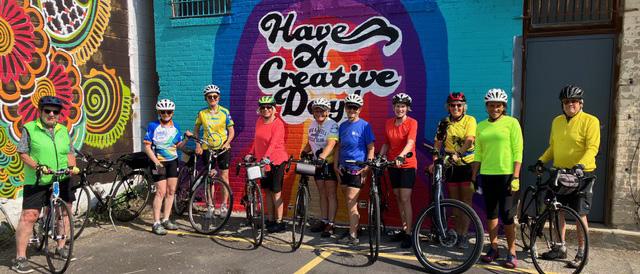


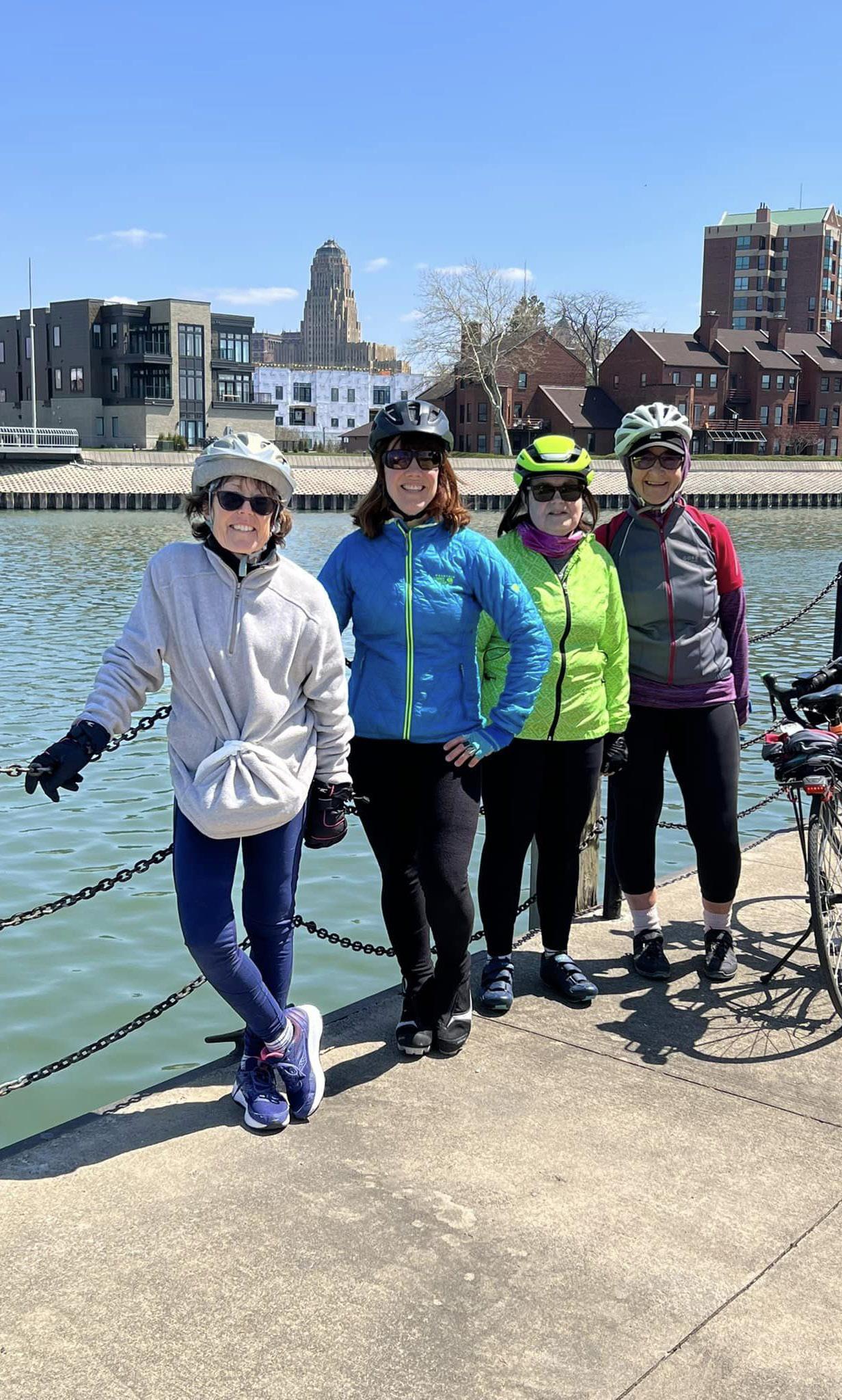 By Daniel Meyer
By Daniel Meyer
If you know how to ride a bicycle, enjoy getting fresh air, want to stay physically fit and enjoy interacting with other people, the Big Wheels Bicycle Club wants to speak with you.
The non-competitive open road cycling club was established over half a century ago with the mindset of offering people of various skill levels the opportunity to have a safe and enjoyable bike riding experience with others. With approximately 100 active members, the organization provides unique settings before, during and after group rides to meet new people and establish friendships with group rides held every day of the week from the beginning of April through late October.
“It’s a great group of people because everyone is so helpful and supportive,” said Karen Teresi, a resident of Tonawanda who has been involved with the Big Wheels Bicycle Club for the past six years and currently serves as the group’s treasurer and membership chairperson. “It’s particularly a great club because we don’t leave anyone behind and fully embrace the group concept. We all work together and have fun doing it.”
The group rides include people
of various ages and experience level, with the majority of the riders being over age 30. Riders who are under the age of 18 can participate but must be accompanied by a parent or legal guardian. While based in Tonawanda, the cyclists travel throughout the northern portion of Erie County and parts of southern Niagara County, with scenic excursions to various points of interest all across Western New York.
Each ride has bicyclists grouped into three clusters based on experience: casual, intermediate, and advanced. The casual riders normally ride about 10 miles per hour for anywhere from 10 to 15 miles, while the intermediate grouping will ride about 12 to 15 miles per hour for roughly 25 to 30 miles. The advanced contingent will cycle consistently at 15 miles per hour and normally take a journey that is at least 40 miles long. Weather conditions and the total number of riders for each week may impact the expected ride speeds and total distance traveled, but club members say every gathering results in a fun and festive atmosphere with the goal of making everyone involved smile and share in the enjoyment of exercising while being outdoors.
“We are a fun and friendly and extremely social group of people,” said Bill Gucwa, a 76-year-old resident of Tonawanda who serves as the president for the organization. “It actually feels like a family with how we have established relationships with each other and look out and care for one another.”
The open road rides lead participants to various destinations throughout the region, including but not limited to downtown Buffalo, Niagara Falls, Lewiston, East Aurora, Clarence and even Southern Ontario. Routine group rides include morning and evening excursions Monday through Friday, along with morning rides on both Saturday and Sunday. Most of the morning rides include a brief stop somewhere along the way to enjoy a meal and engage in casual conversation.
The flexibility of the club allows for the introduction of new riding routes and special occasions that include holiday-themed rides and an annual banquet to recognize all participants and praise those riders with the top mileage tallies for the year.
Members of the Big Wheels Bicycle Club pay annual membership dues of $20, a fee that covers an individual rider or an entire house-
hold. Anyone who joins is asked to own or have access to at least one lightweight geared bike or a pedal assist e-bike that is in good, rideable condition with spare inner tubes that fit each wheel in case of a flat tire. A bicycle helmet and at least one mirror mounted to the bike are also mandatory for all members.
“If you want to be active, especially if you are retired, I encourage anyone to contact us, even if you are a beginner,” said Teresi, who turned age 70 this year. “I think it’s also important for everyone to know that we are cautious and always aware of our surroundings, especially when it comes to other traffic. Being conscious of safety and obeying traffic signals and stop signs is a priority.”
How to Participate
For more information about the Big Wheels Bicycle Club, including upcoming ride times and locations and details on how to apply to become a member, call (716) 308-4127 or visit www.bigwheelsbikeclub.com.
Page 20 • IN GOOD HEALTH – Buffalo & WNY’s Healthcare Newspaper • August 2023
































































































































 By Deborah Jeanne Sergeant
By Deborah Jeanne Sergeant








 By Deborah Jeanne Sergeant
By Deborah Jeanne Sergeant


























 By Daniel Meyer
By Daniel Meyer